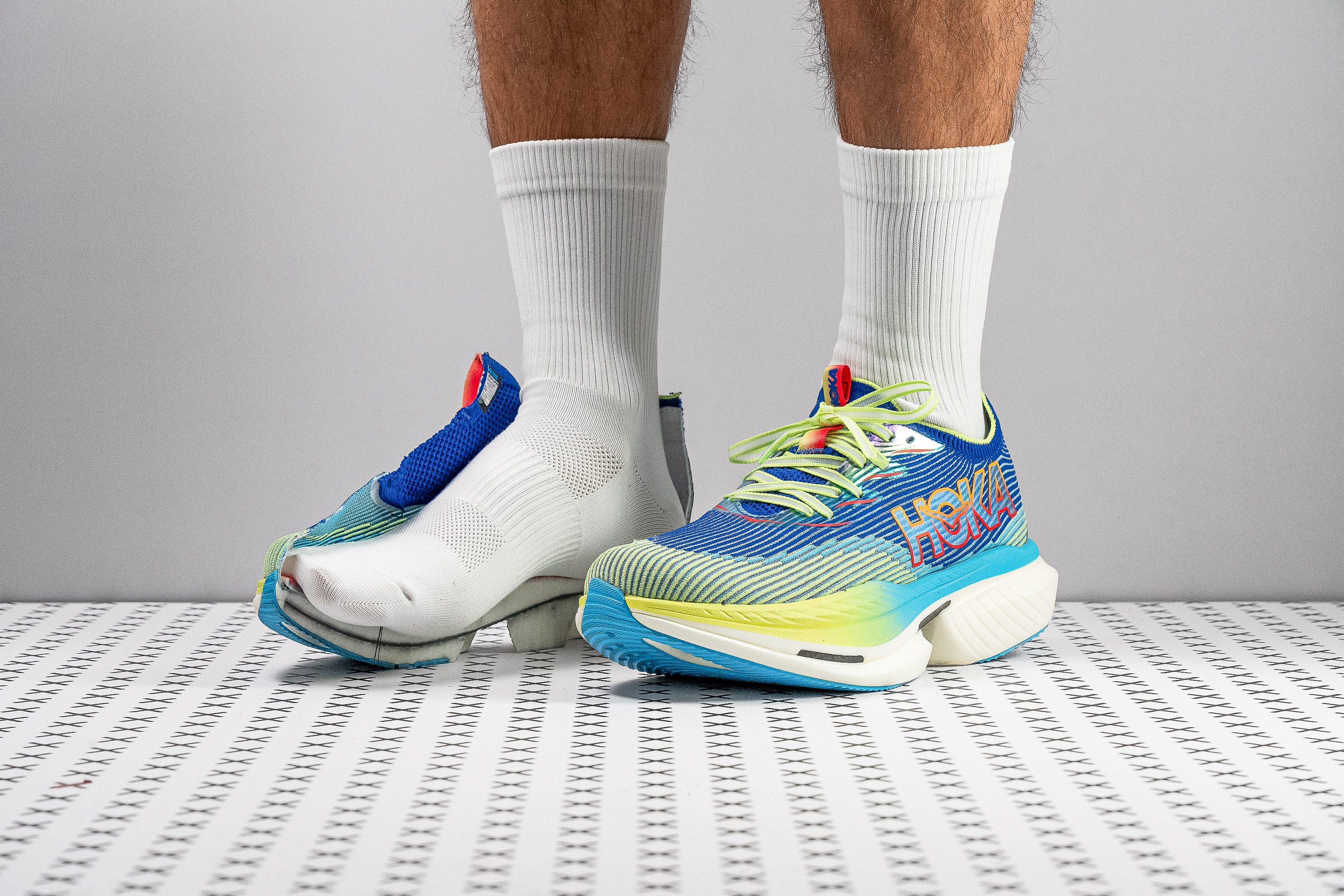Our verdict
Pros
- Thrilling, fun ride
- Leg-saving midsole
- Marathon-ready
- Fantastic energy return
- Enhances forward motion
- Plush and bouncy PEBA foam
- Excellent durability
- Excels at long runs
Cons
- A bit heavy
- Some stability issues
- Pricey at $275
- Not the grippiest supershoe
Audience verdict
- Top 27% in Hoka running shoes
Comparison
The most similar running shoes compared
+ + Add a shoe | |||||
|---|---|---|---|---|---|
| Audience score | 88 Great! | 89 Great! | 87 Great! | 87 Great! | |
| Price | £250 | £150 | £285 | £230 | |
| Pace | CompetitionTempo | Tempo | Competition | Competition | |
| Shock absorption | High | High | High | High | |
| Energy return | High | Moderate | High | High | |
| Traction | Moderate | High | Moderate | High | |
| Arch support | Neutral | Neutral | Neutral | Neutral | |
| Weight lab Weight brand | 8.8 oz / 249g 9.3 oz / 264g | 9.5 oz / 268g 9.5 oz / 269g | 7.1 oz / 201g 7 oz / 198g | 7.8 oz / 220g 7.7 oz / 218g | |
| Lightweight | ✓ | ✗ | ✓ | ✓ | |
| Drop lab Drop brand | 9.5 mm 7.0 mm | 10.1 mm 10.0 mm | 8.5 mm 8.0 mm | 9.5 mm 8.0 mm | |
| Strike pattern | HeelMid/forefoot | Heel | HeelMid/forefoot | HeelMid/forefoot | |
| Size | True to size | Slightly small | Slightly small | True to size | |
| Midsole softness | Soft | Soft | Soft | Balanced | |
| Difference in midsole softness in cold | Small | Normal | Small | Small | |
| Toebox durability | Good | Decent | Bad | Good | |
| Heel padding durability | Good | Decent | Good | Good | |
| Outsole durability | Good | Decent | Bad | Good | |
| Breathability | Moderate | Moderate | Breathable | Breathable | |
| Width / fit | Medium | Narrow | Medium | Medium | |
| Toebox width | Narrow | Narrow | Medium | Medium | |
| Stiffness | Stiff | Stiff | Stiff | Stiff | |
| Torsional rigidity | Stiff | Stiff | Stiff | Stiff | |
| Heel counter stiffness | Flexible | Flexible | Flexible | Flexible | |
| Plate | Carbon plate | Carbon plate | Carbon plate | Carbon plate | |
| Rocker | ✓ | ✗ | ✓ | ✓ | |
| Heel lab Heel brand | 39.8 mm 39.0 mm | 37.4 mm 39.0 mm | 38.1 mm 40.0 mm | 38.1 mm 40.0 mm | |
| Forefoot lab Forefoot brand | 30.3 mm 32.0 mm | 27.3 mm 29.0 mm | 29.6 mm 32.0 mm | 28.6 mm 32.0 mm | |
| Widths available | Normal | NormalWide | Normal | Normal | |
| Orthotic friendly | ✓ | ✓ | ✗ | ✓ | |
| Season | All seasons | All seasons | SummerAll seasons | SummerAll seasons | |
| Removable insole | ✓ | ✓ | ✗ | ✓ | |
| Ranking | #137 Top 37% | #115 Top 31% | #160 Top 43% | #145 Top 39% | |
| Popularity | #156 Top 42% | #55 Top 15% | #23 Top 7% | #33 Top 9% |
Who should buy
We think the Hoka Cielo X1 is a fantastic choice for:
- Runners in search of an exciting supershoe who aren't concerned about a little extra weight.
- Hoka fans craving the brand's signature rockered ride in a supremely cushioned, marathon-ready design.
- Those who prefer a snug fit and desire a super-rockered ride for both long runs and competitive races.
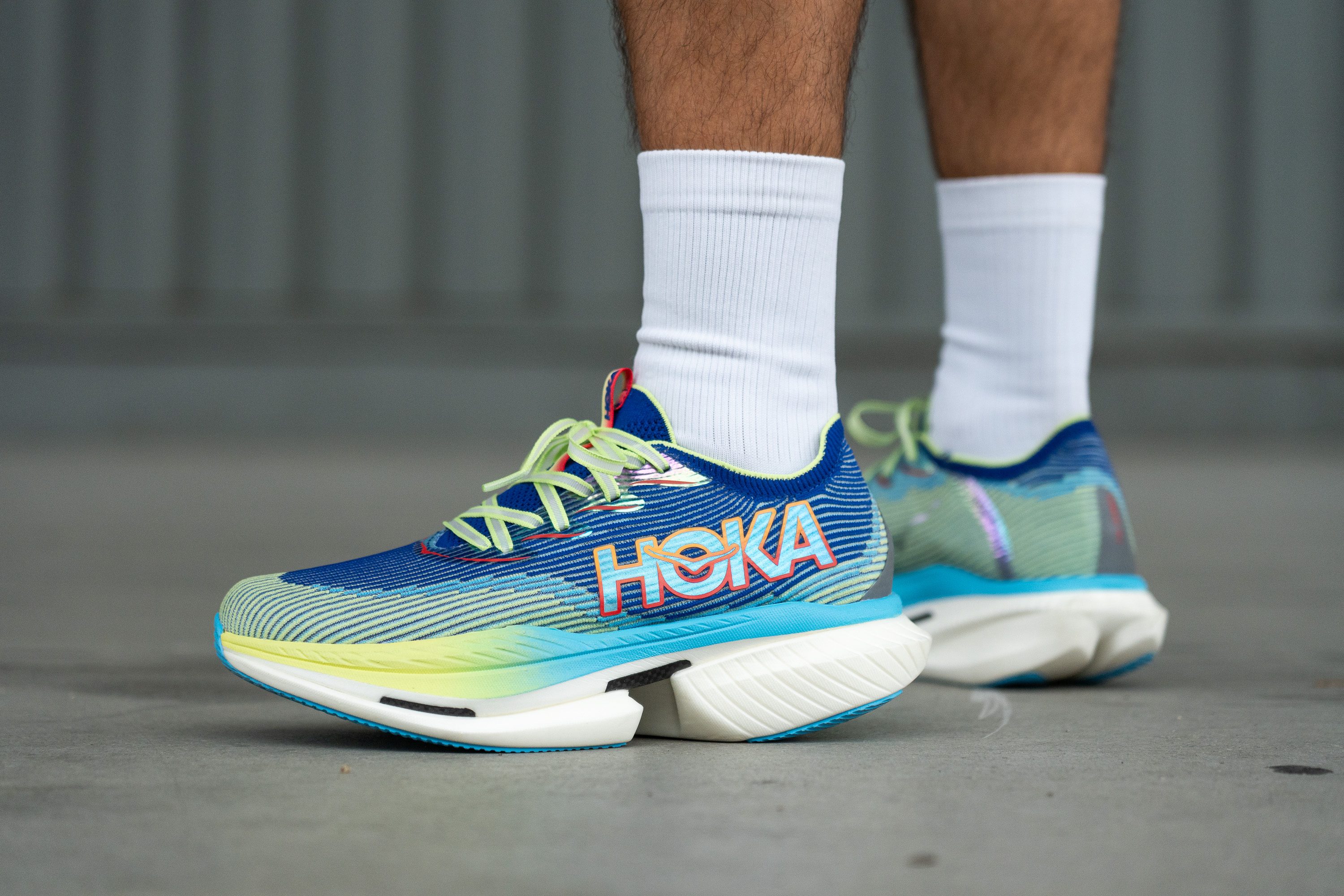
Who should NOT buy
While the Cielo X1 may catch your eye as a high-end racer, we found it lacks the versatility needed for shorter events. Our lab tests revealed that for 5K/10K races, you're better off with lighter, more agile options such as the Nike Vaporfly 3 or the Hoka Rocket X 2.
Weight is another aspect where the Cielo X1 might disappoint some even for the marathon distance. We have tested alternatives that significantly undercut the Cielo X1's weight, like the featherlight Nike Alphafly 3 or the sleek Saucony Endorphin Elite. These models deliver the same cushioning without the added bulk.
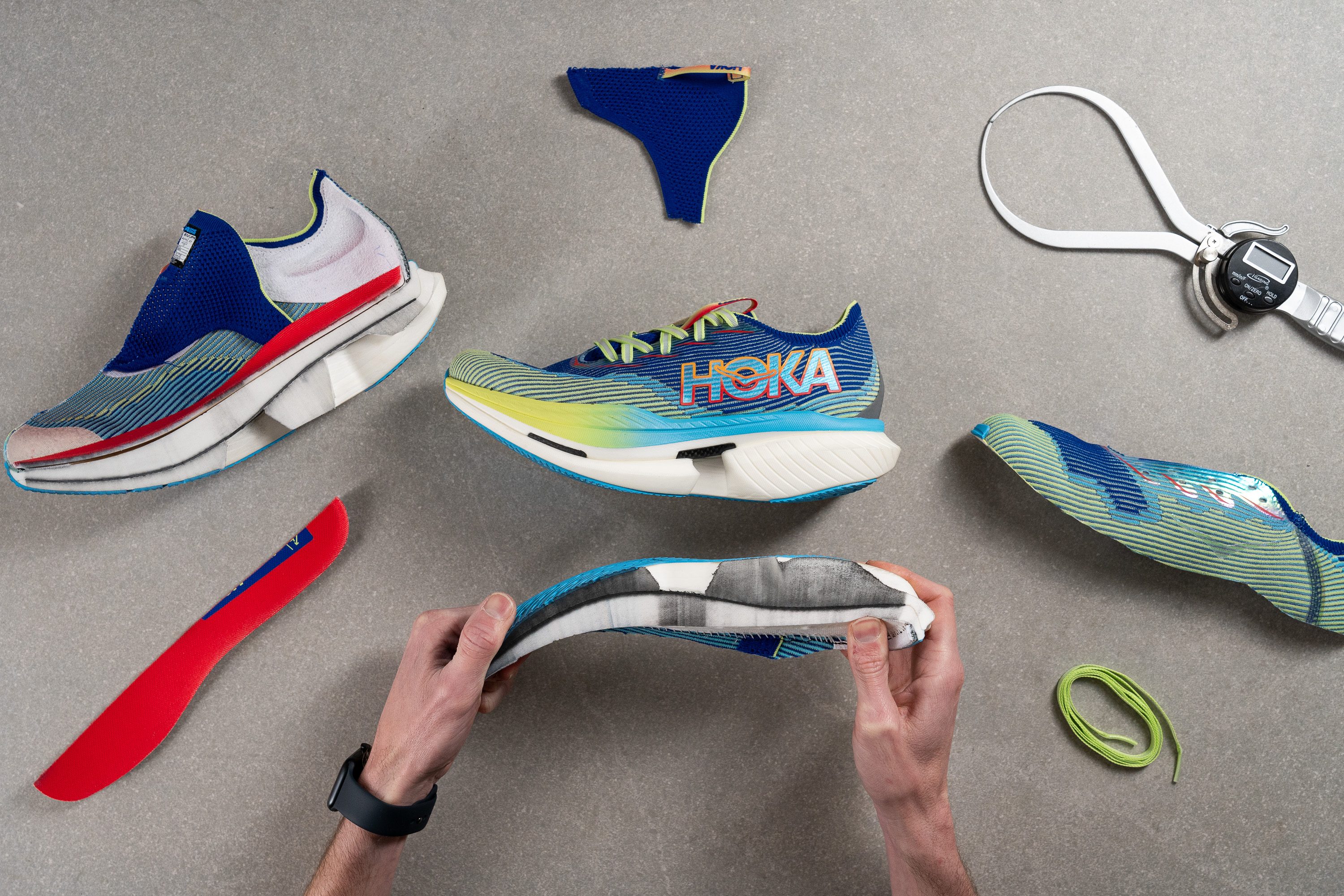
Lastly, for runners with wider feet, the Cielo X1 might not be the best fit. Our measurements led us to the New Balance FuelCell SuperComp Elite v4, which not only boasts an endless name and a spacious upper, but also packs a PEBA-based midsole and carbon plate.
Cushioning
Shock absorption
Those chasing maximum foam underfoot will feel right at home with the Cielo X1. It packs a mountain of cushioning, confirmed by our lab results: 147 SA in the heel and 119 SA in the forefoot. This cements its role as a long-distance powerhouse.
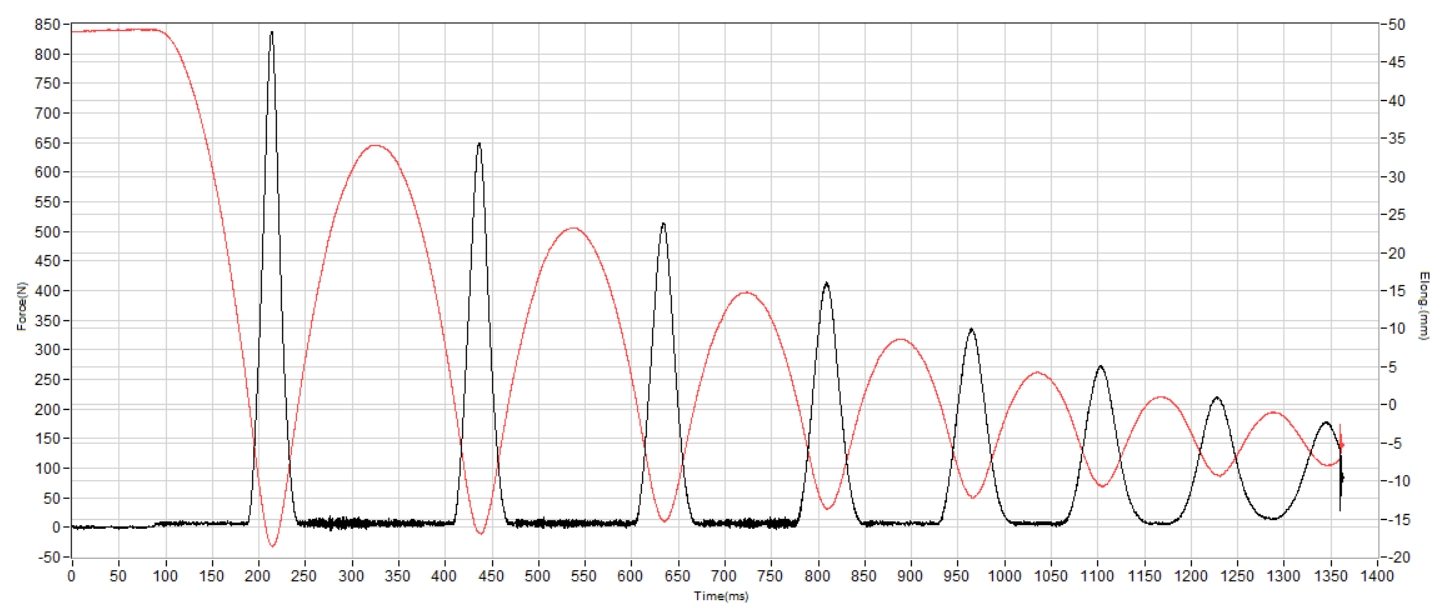
| Hoka Cielo X1 | 147 SA |
| Average | 129 SA |
Energy return
We tested the Cielo X1 and found excellent energy return at 74.4%, clearly in supershoe territory. That said, considering its sky-high price tag, it’s simply delivering what any premium-built, race-day-ready model should.
It also matches our experience while running on it, providing a spring-loaded feel that only a handful of shoes can match.
| Hoka Cielo X1 | 74.4% |
| Average | 58.5% |
Heel stack
World Athletics rules demand that all brands must keep their shoes under the 40-mm stack height limit. We found that the Cielo X1 masterfully meets this challenge, coming in at a snug 39.8 mm. It's like walking a tightrope but, thankfully, landing safely on the side of approval.
Seems clear to us that, if you're searching for a maximalist shoe that's both cushioned and legal for race day, the Cielo X1 is a standout choice.
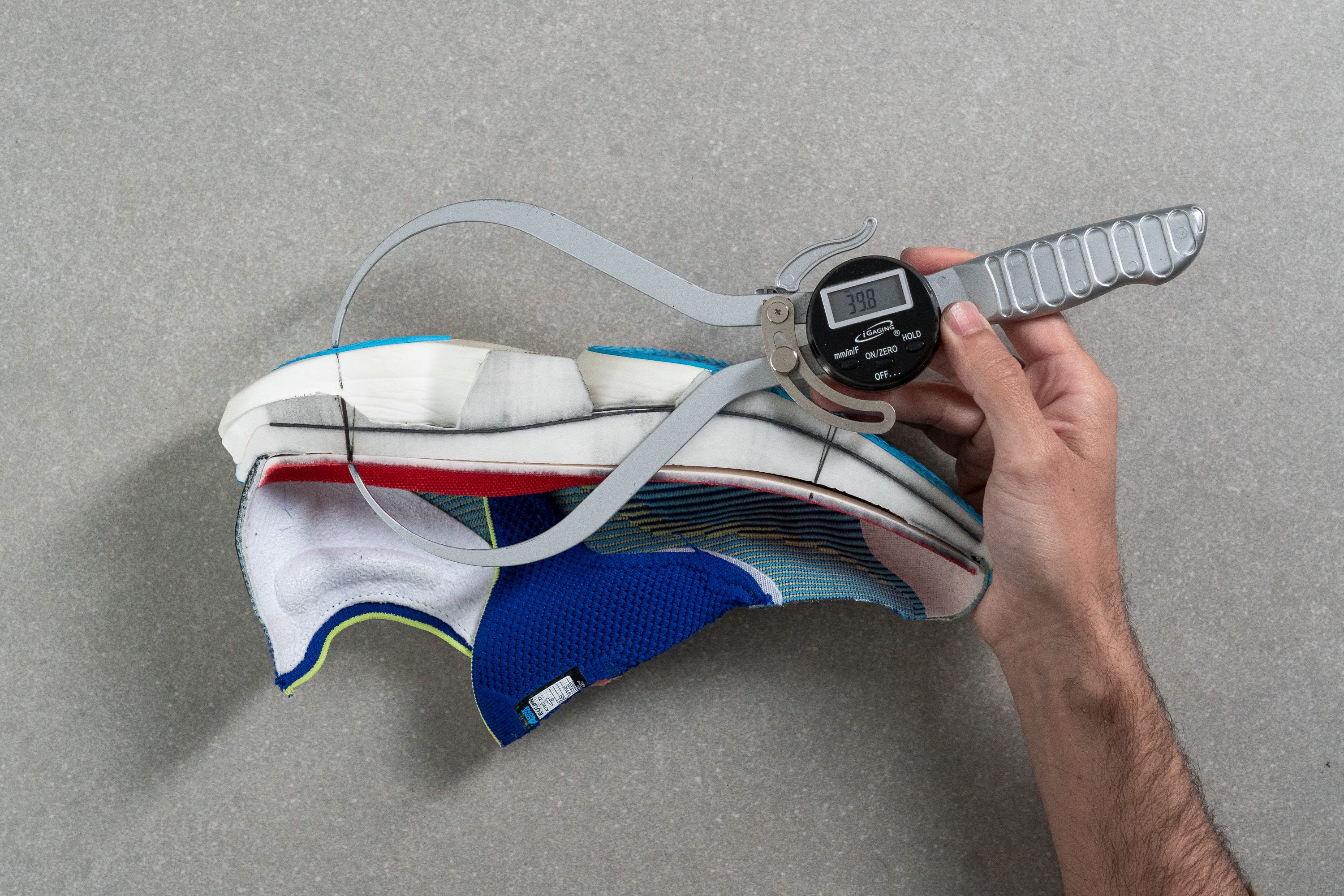
| Hoka Cielo X1 | 39.8 mm |
| Average | 34.8 mm |
Forefoot stack
We found the forefoot to be slightly slimmer than expected, with Hoka's official specs at 32 mm and our measurements showing 30.3 mm.
This minor variance—less than 2 mm—doesn't change anything. From our perspective, it remains exceptionally plush also for midfoot and forefoot strikers.
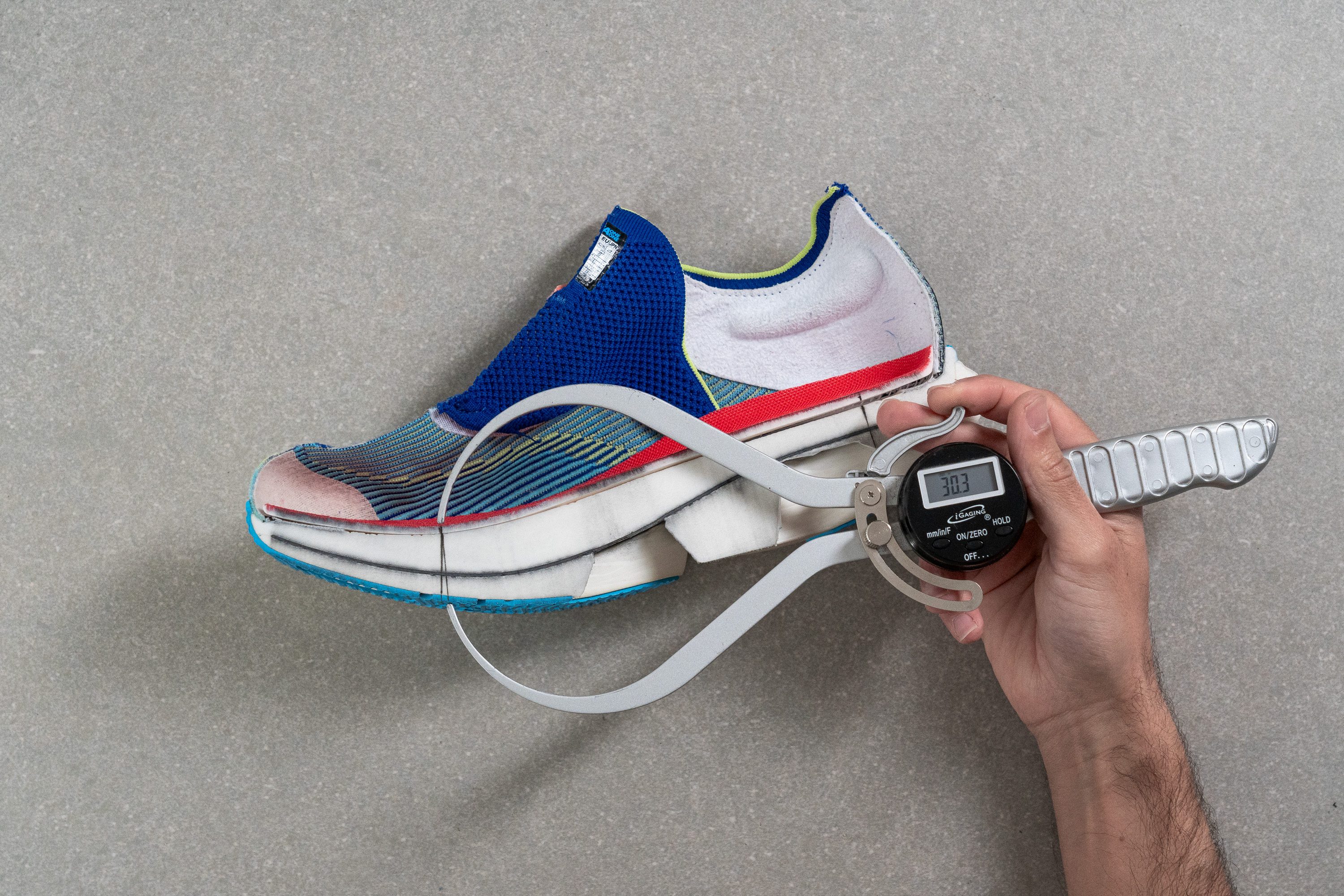
| Hoka Cielo X1 | 30.3 mm |
| Average | 26.2 mm |
Drop
Hoka is well-known for making shoes with a low heel-to-toe drop, typically between 4 and 5 mm. However, for the Cielo X1, the brand advertises a 7-mm drop.
After conducting our tests, we discovered a 9.5-mm drop. While this might seem like a big difference at first, it's actually not a big deal in a shoe with a strong rocker design like this one.
In our tests, the shoe felt just like any average drop shoe out there, and when using a midfoot strike, it's nearly impossible to notice any difference with a 7, 8, or 10 mm shoe.
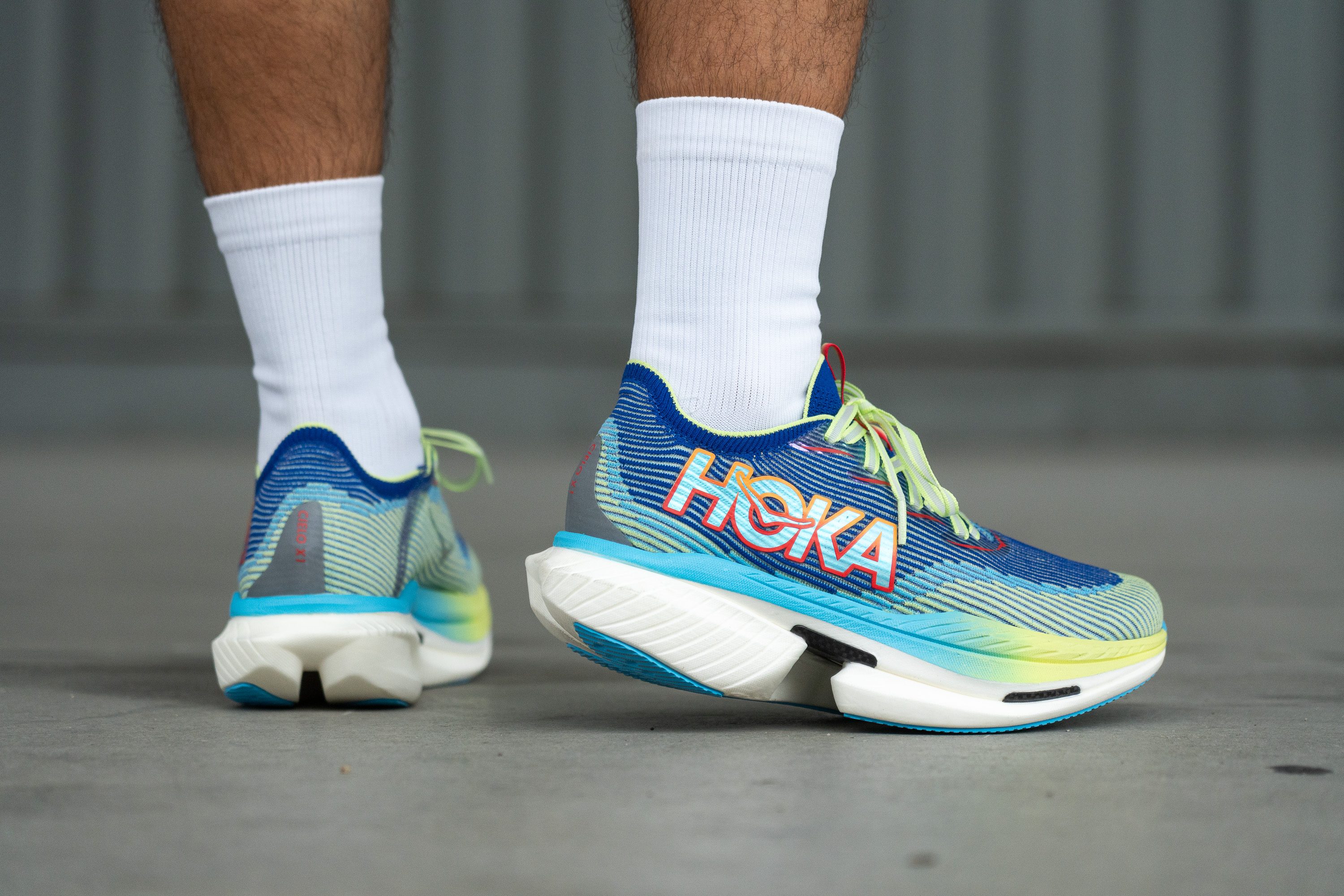
On the flip side, runners who land on their heels might find it feels more like a 5-mm drop shoe. This is because the foam compresses quite a bit upon impact. But, thanks to the shoe's rocker design, it still rolls you forward smoothly.
| Hoka Cielo X1 | 9.5 mm |
| Average | 8.6 mm |
Midsole softness
The Cielo X1 stands out as yet another top-tier running shoe featuring a dual-density PEBA midsole, akin to the elite carbon-plated racers dominating the market today.
The top layer, sitting just above the carbon plate and closest to the foot, is remarkably soft at 15.5 HA. This layer delivers an incredibly plush, cloud-like sensation underfoot.
While Hoka has yet to put a name on its PEBA foam, we've concluded that it rivals the finest on the market. It offers an exceptional, super-high energy return. Essentially, this midsole embodies everything we anticipate from a £270 high-performance supershoe.

| Hoka Cielo X1 | 15.5 HA |
| Average | 20.4 HA |
Secondary foam softness
Beneath the winged carbon-fibre plate lies another layer of PEBA foam, this one featuring large cutouts to minimise weight as much as possible and a firmer feel. Its denser formulation also naturally leads to a firmer feel. In our measurements, we recorded a softness of 31.0 HA—precisely double that of the top layer.
This strategic design shift is Hoka's clever way of enhancing stability given the shoe's substantial stack height. It's also a smart move that prevents the shoe from feeling too mushy underfoot, ensuring a more dynamic, less squishy ride that encourages picking up the pace.
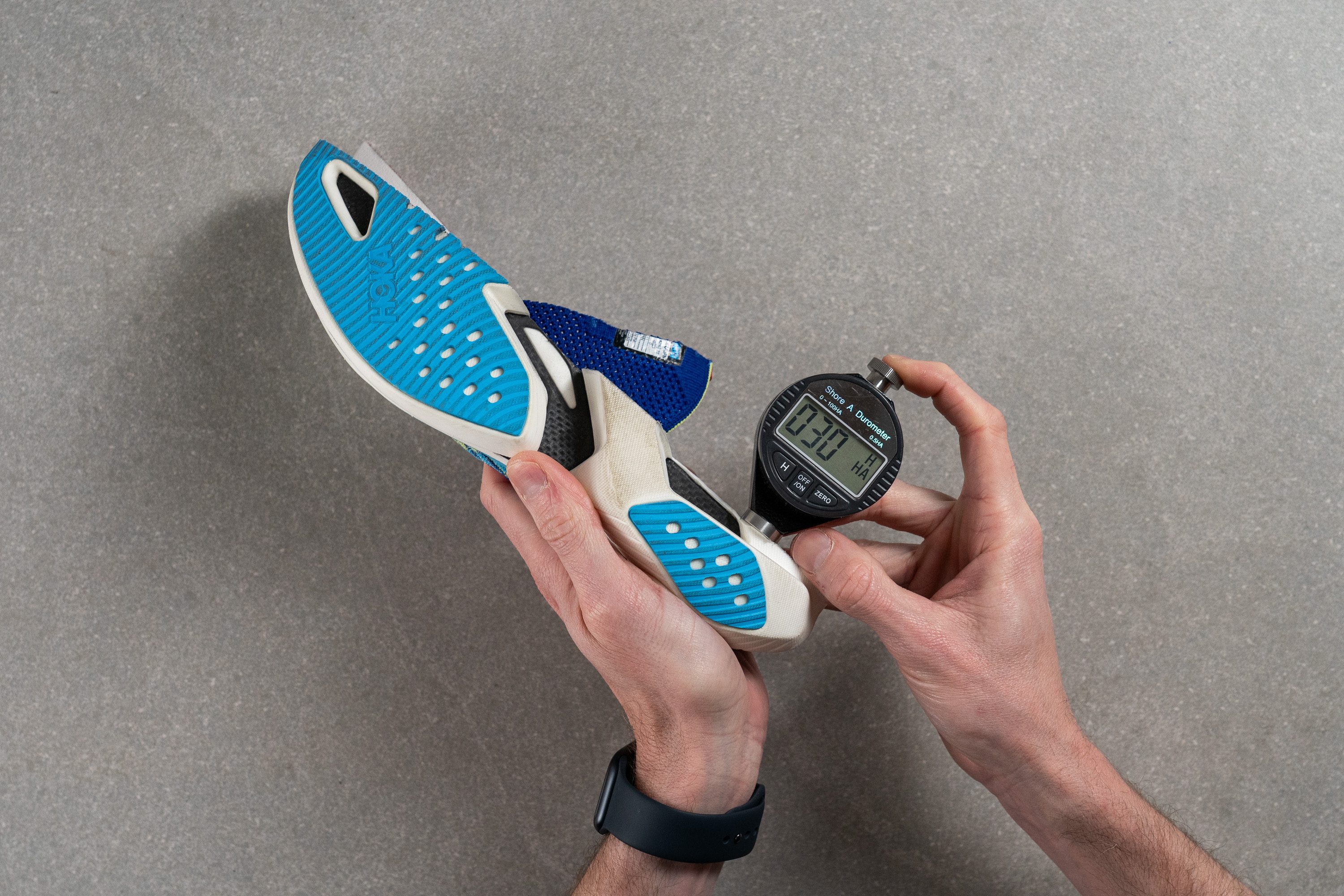
| Hoka Cielo X1 | 31.0 HA |
| Average | 22.7 HA |
Rocker
One standout feature that Hoka has made famous in the running world is the rocker design, and the Cielo X1 truly exemplifies this, offering one of the most pronounced rockered sensations we've encountered in any running shoe, especially because of the heel curvature.
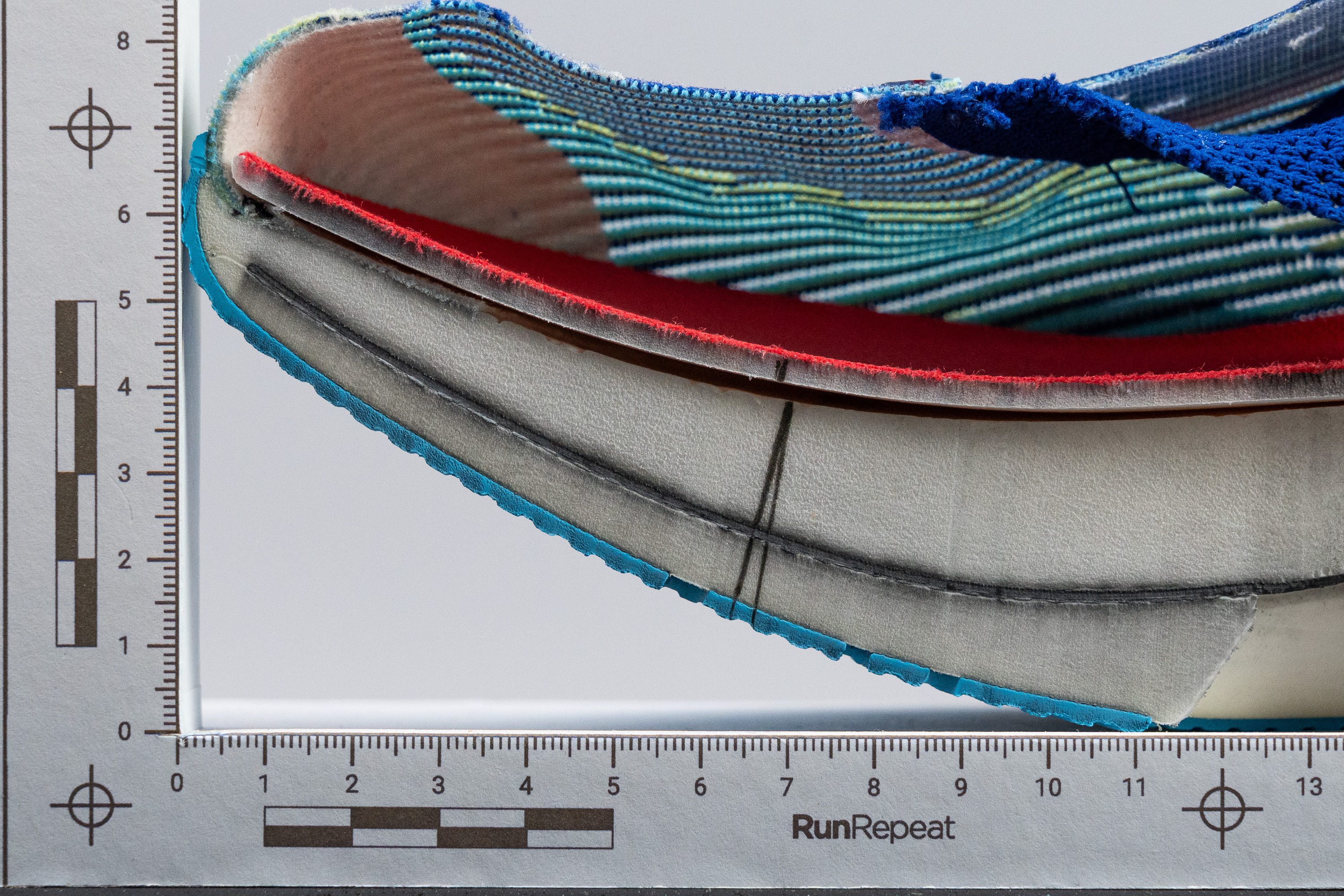
Whether this is a positive or negative trait can vary. As detailed in our guide on running shoe rockers, this innovative design can significantly facilitate forward motion, providing immense support for some runners, like those suffering from plantar fasciitis. However, it might also alter the natural feel of running.
Plate
At first glance, the Cielo X1 might seem to boast a typical spoon-shaped, carbon-fibre plate nestled between two plush layers of PEBA foam, yet Hoka has ingeniously advanced the design with two subtle yet impactful modifications.
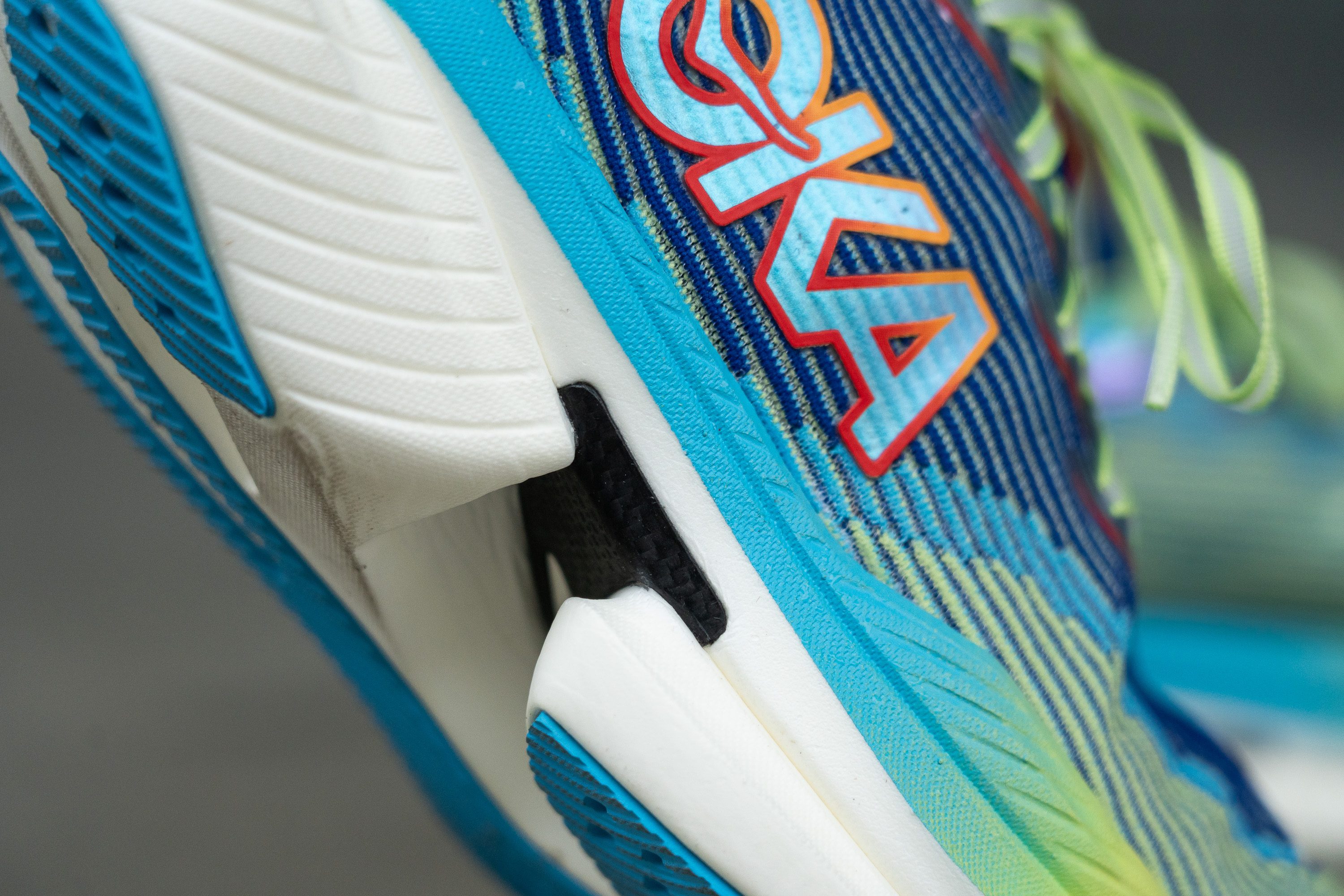
The plate now showcases a strategic central cutout paired with innovative wing-like extensions, reminiscent of the design seen in the Saucony Endorphin Speed 4. These thoughtful tweaks significantly enhance stability and flexibility.

Size and fit
Size
Hoka Cielo X1 fits true to size (45 votes).
Width / Fit
Slipping our feet into the Cielo X1 for the first time, we immediately sensed its snug fit. With a measured width of 93.0 mm, it's clear that those with wide feet need to be comfortable with a very tight fit; otherwise, they may find the shoe too narrow, especially since there's no option for wide sizing.
For those with narrow to average feet, the shoe offers a performance-oriented fit typical of a supershoe. Yet, anyone considering this model for weekly long runs should be mindful of its snug design.

| Hoka Cielo X1 | 93.0 mm |
| Average | 95.1 mm |
Toebox width
We conducted a second measurement on the gel cast to gauge the tapering of the Cielo X1, and we found it to be quite snug at just 70.9 mm.
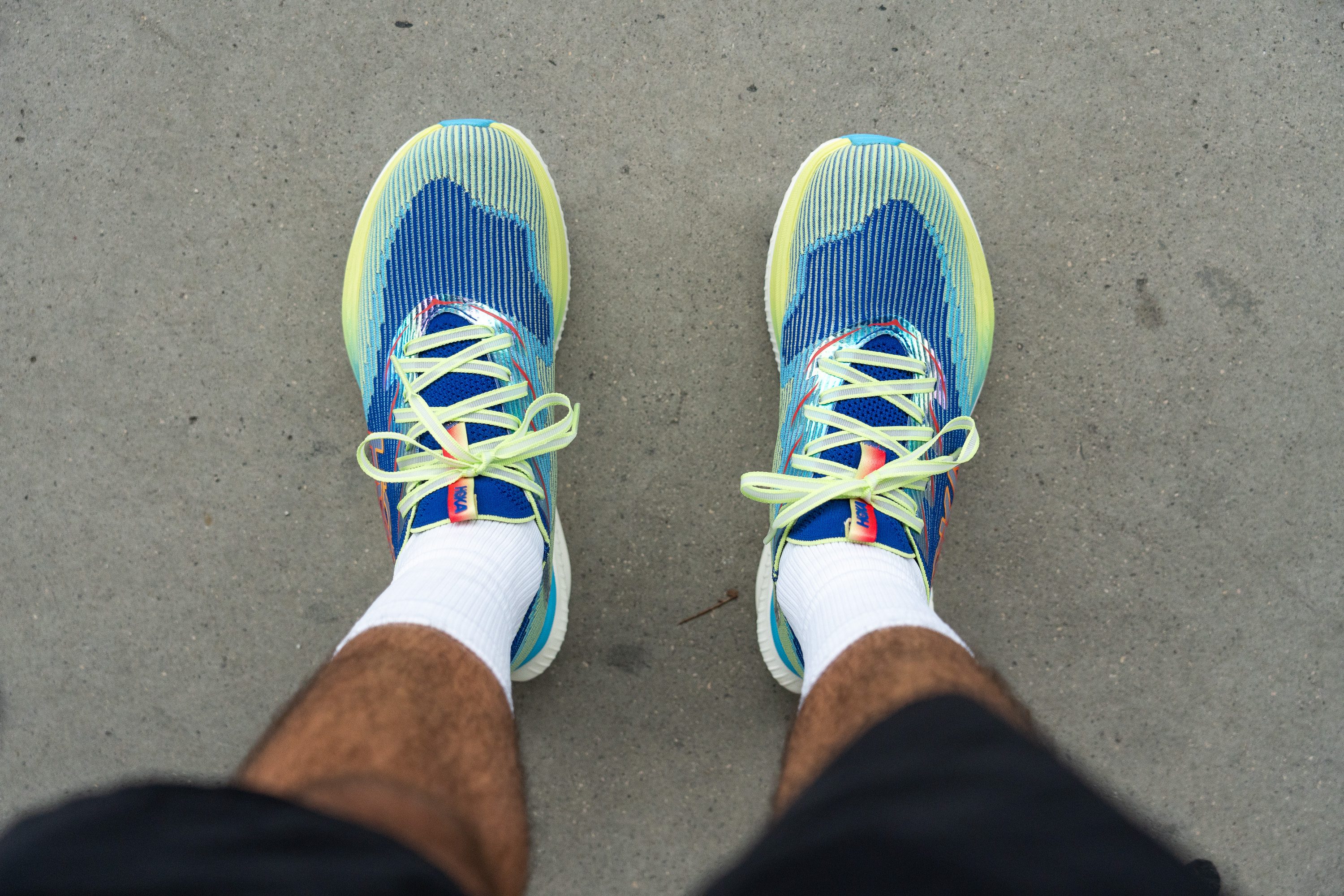
We believe there are two key factors behind this design. Firstly, being a Hoka shoe, it's consistent with the brand's tendency towards tapered toeboxes and narrow designs. Secondly, this is also a strategic move to enhance support—combining a wide base at the forefoot with a narrower upper offers an instant stability boost.
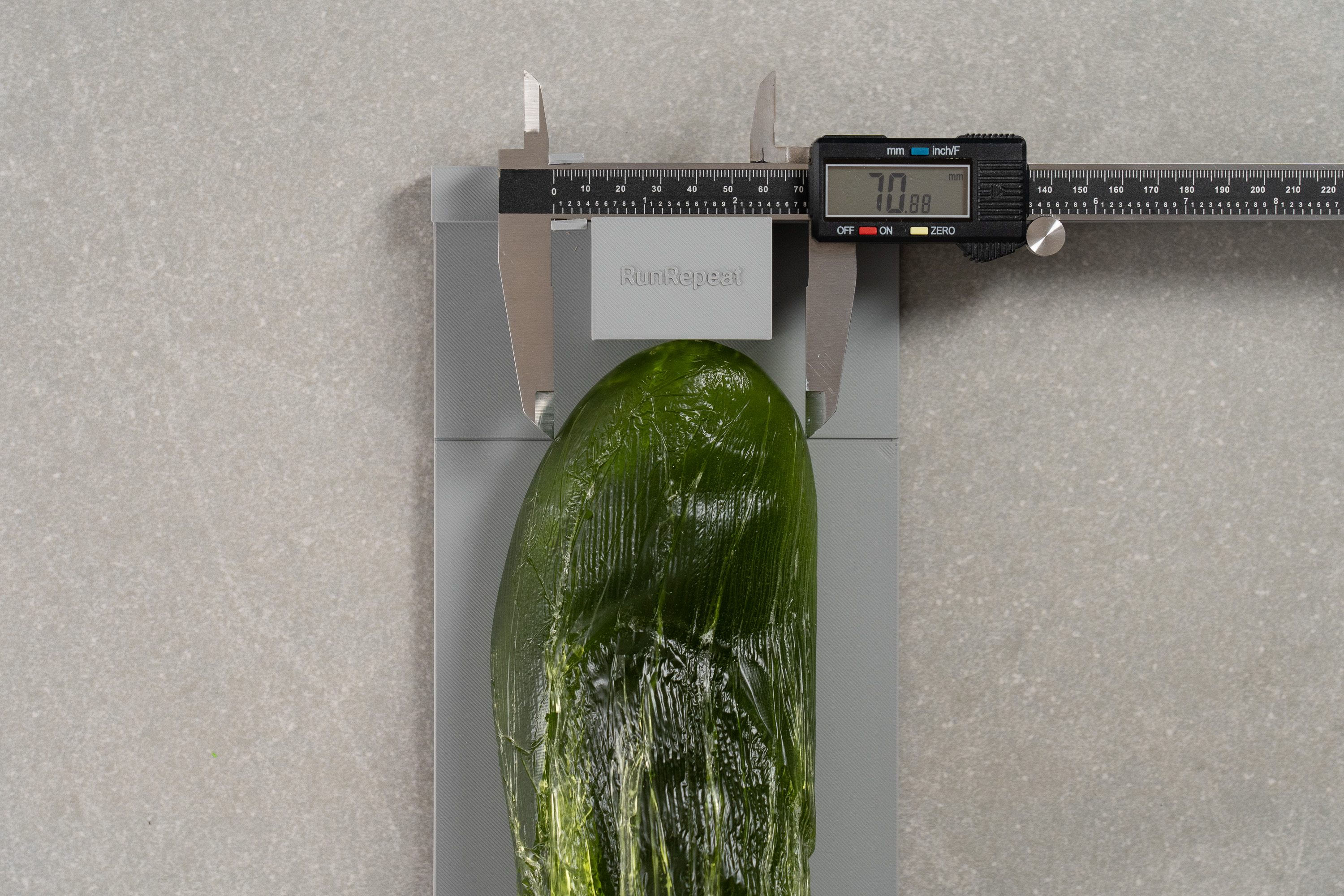
| Hoka Cielo X1 | 70.9 mm |
| Average | 73.2 mm |
Toebox height
After our third measurement of 27.9 mm, we concluded that the Cielo X1 provides ample vertical volume—essential for long runs exceeding 2 hours when foot swelling becomes a factor.
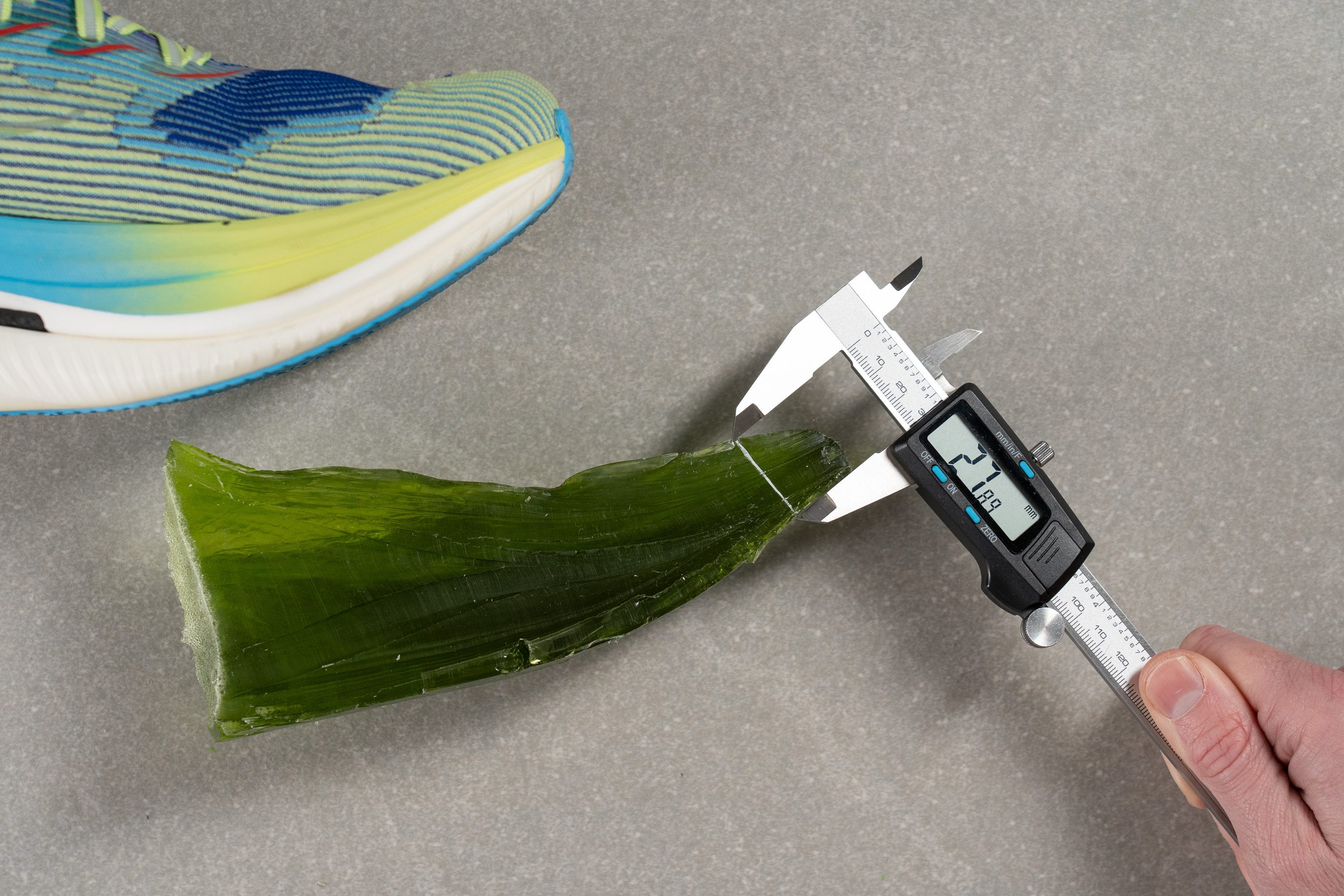
| Hoka Cielo X1 | 27.9 mm |
| Average | 27.1 mm |
Traction / Grip
Traction test
We tested the grip of the Cielo X1 and measured a score of 0.39. That’s not exactly top-tier, but it’s good for an outsole with a lot of exposed foam.
On dry surfaces, we found the traction more than capable. It also held up reasonably well during wet conditions, although runners seeking top-tier grip might want to explore other supershoes.
| Hoka Cielo X1 | 0.39 |
| Average | 0.48 |
Outsole design
The Cielo X1 stands out with massive rubber coverage—especially for a supershoe. HOKA didn’t hold back, wrapping the entire forefoot and most of the heel in blue rubber. However, we found this setup comes at a cost—it noticeably adds weight, making the X1 heavier than most of its carbon-plated rivals.
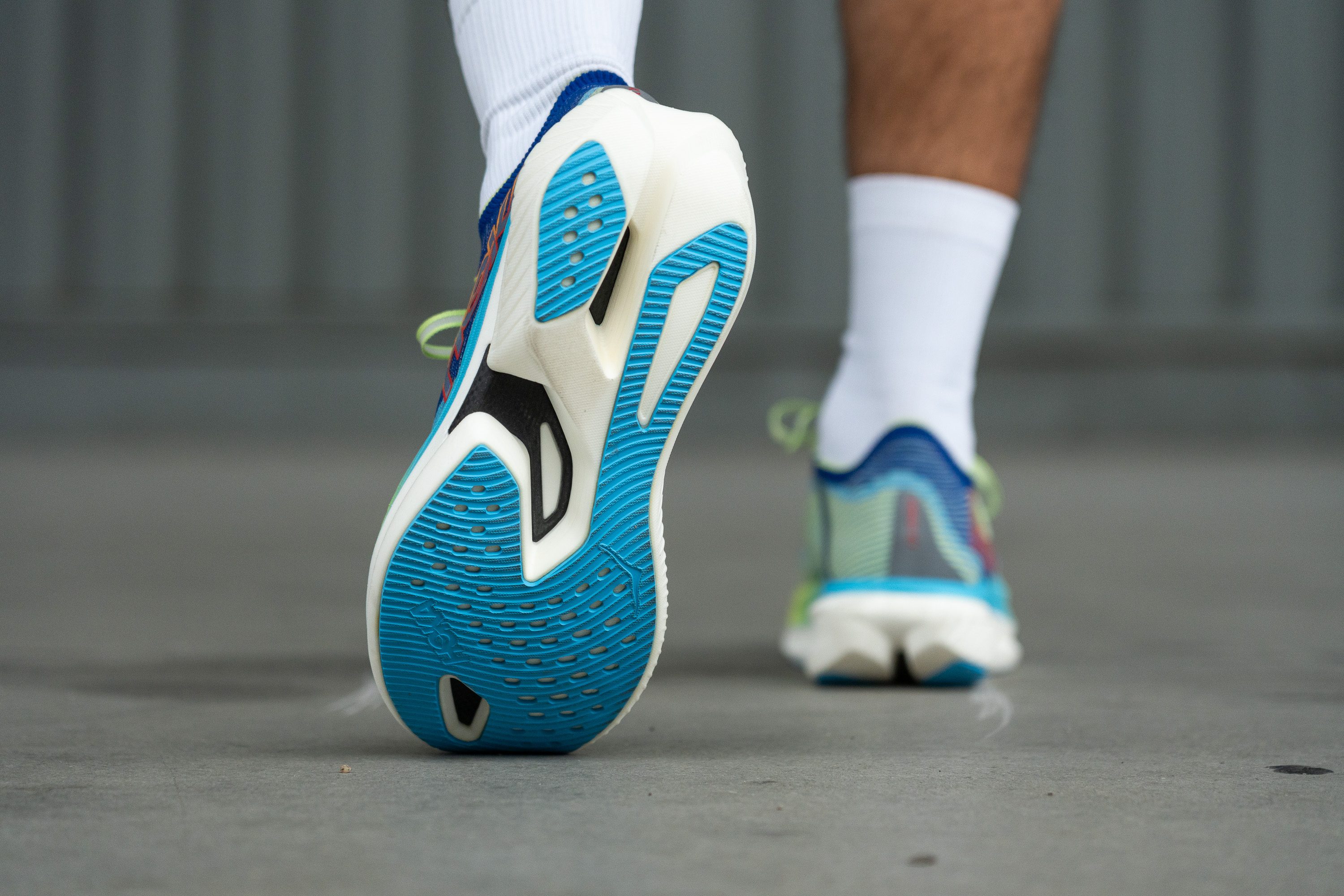
Flexibility / Stiffness
We’ve previously discussed the high torsional rigidity of the Cielo X1, yet we still needed to measure its stiffness in our standard 90-degree bend test.
Given its carbon plate, we anticipated a significant reading, but it came in a bit below other supershoes at 19.3N, making it ideal for fast-paced long runs, which is the best use in our view for this shoe.
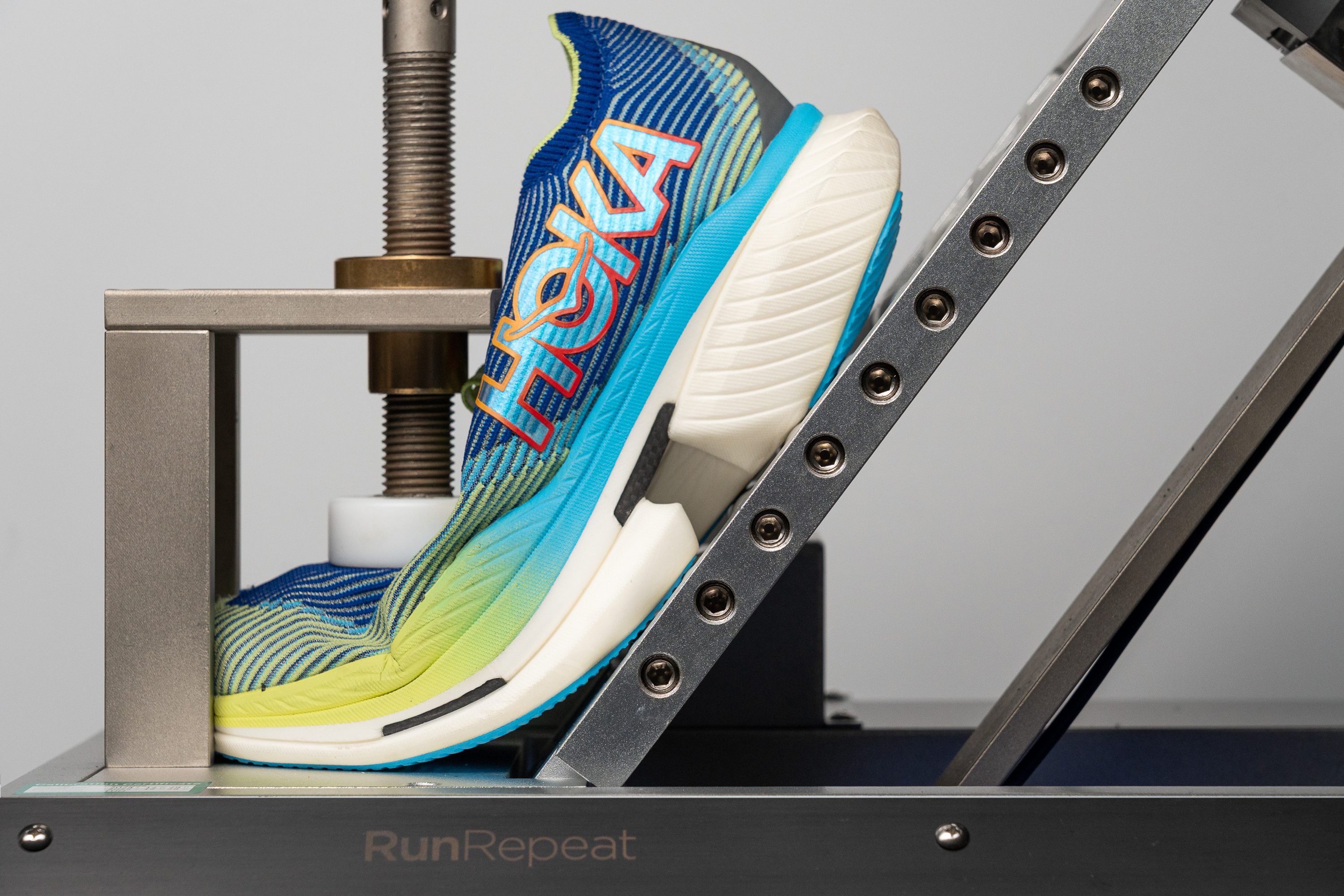
| Hoka Cielo X1 | 19.3N |
| Average | 15.3N |
Stiffness in cold (%)
We were curious to see how the stiffness of the Cielo X1 would be affected by cold temperatures.
True to our expectations for a PEBA-based foam, the change was quite small—only a 10.6% increase. This is certainly encouraging news!
| Hoka Cielo X1 | 11% |
| Average | 33% |
Weight
The Hoka Cielo X1's weight is the elephant in the room. While the trend for racing shoes is to go lighter each year, Hoka took a bold step with an 8.8-oz (249g) model that's noticeably heavier than competitors. Yet, to be fair, when you're running the weight doesn't feel as burdensome as you might think.
For those who prioritise lightness, the Cielo X1 might not be the top choice. However, if you're willing to trade a few ounces for enhanced cushioning and comfort, we see this shoe as an Audi A8, ready to cruise the Autobahn at ultra-high speeds with supreme comfort.
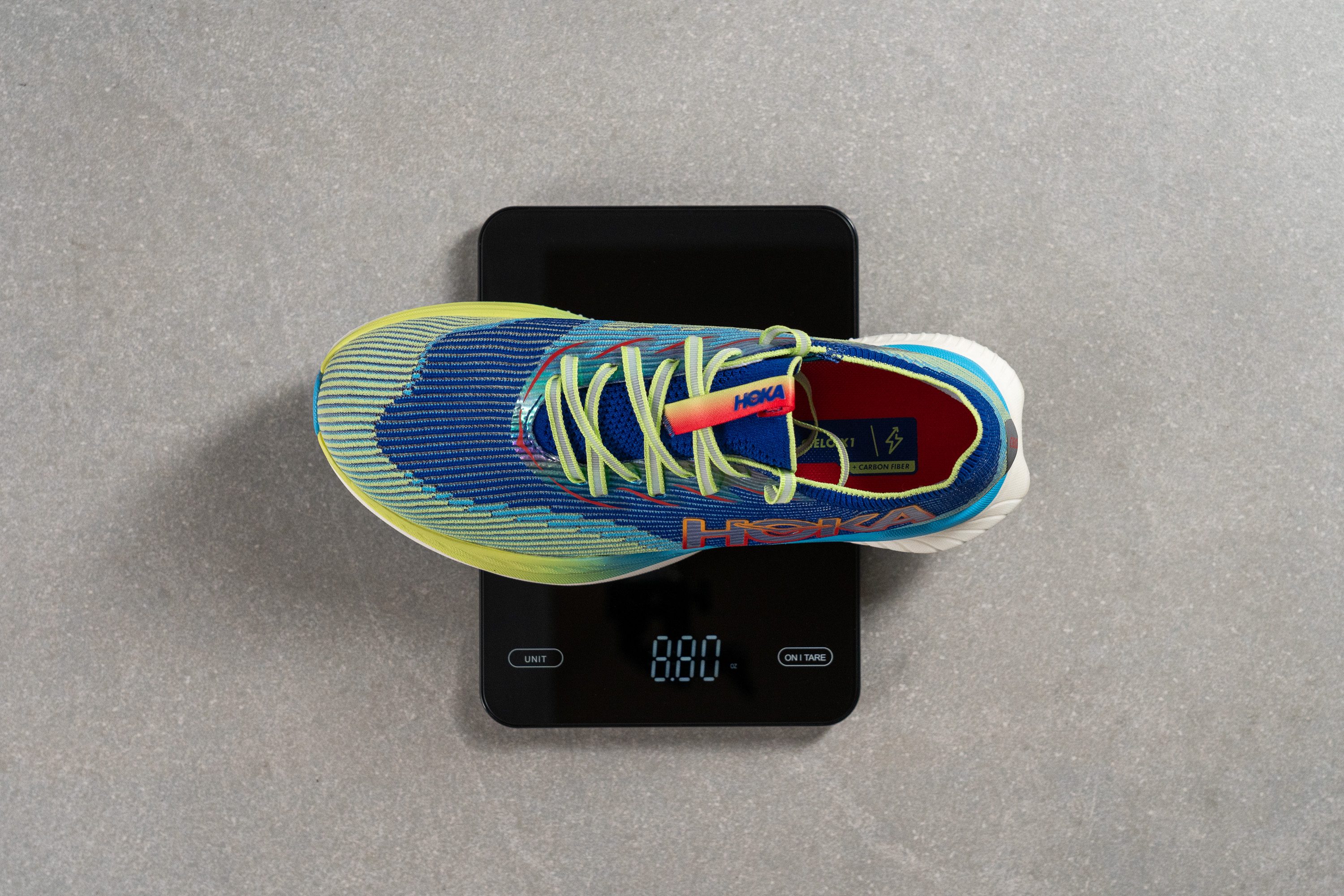
| Hoka Cielo X1 | 8.8 oz (249g) |
| Average | 9.3 oz (264g) |
Breathability
The Cielo X1 isn't just a head-turner with its stylish appearance—we found it's also about comfort. The knit, reminiscent of corduroy (!) at first glance, offers more than meets the eye.
Our breathability test yielded a decent 3/5 score, respectable for a knit but not groundbreaking at all.
Diving deeper with our light test, we noticed Hoka smartly varied the upper's thickness—thinner at the toebox for flexibility and thicker around the midfoot and heel for enhanced stability, a strategic choice for the shoe's height.
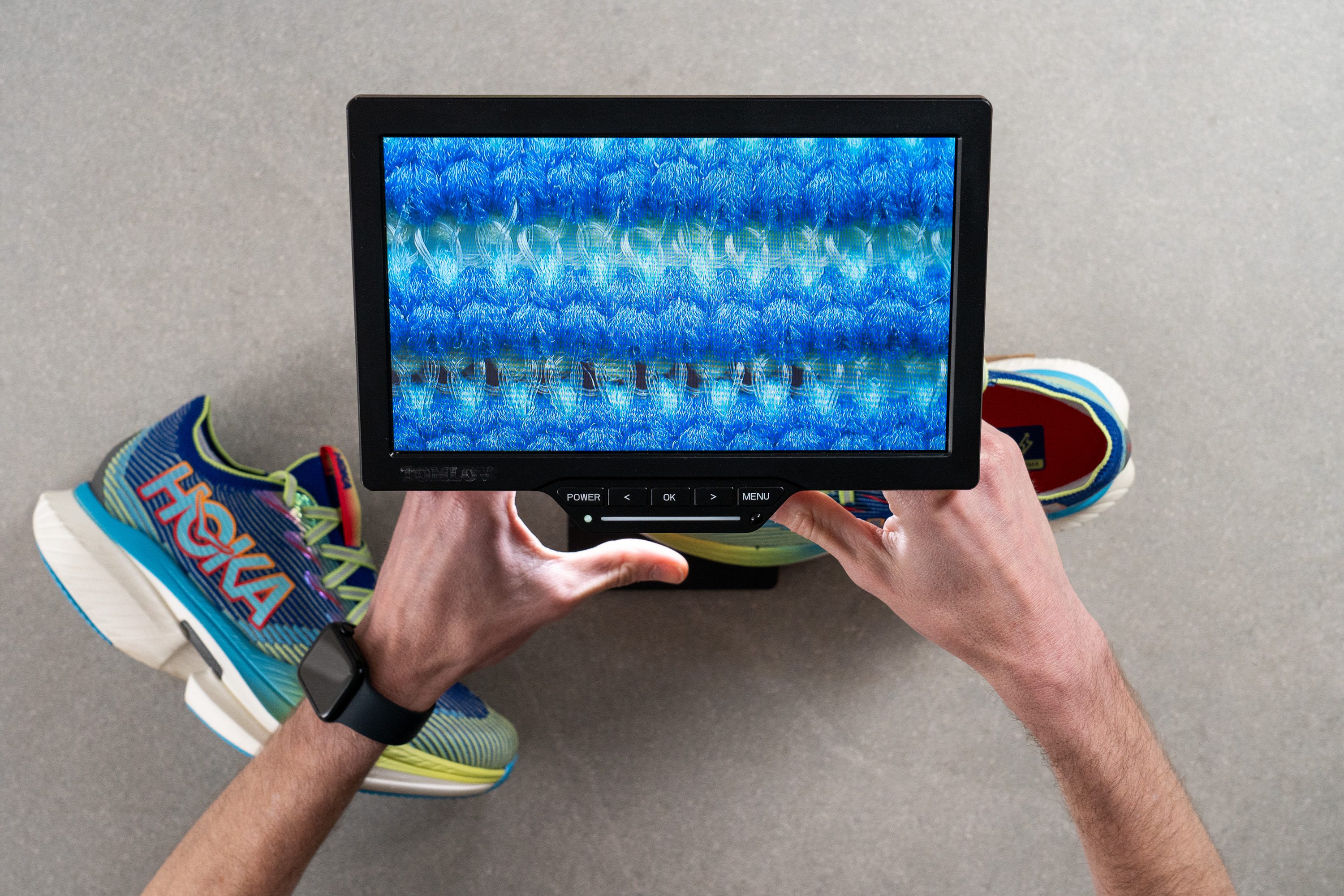
Upon closer inspection under the microscope, the knit upper revealed an unexpected feature—despite its dense appearance, there are subtle channels between the rows allowing for airflow, contributing to its just-okay breathability.
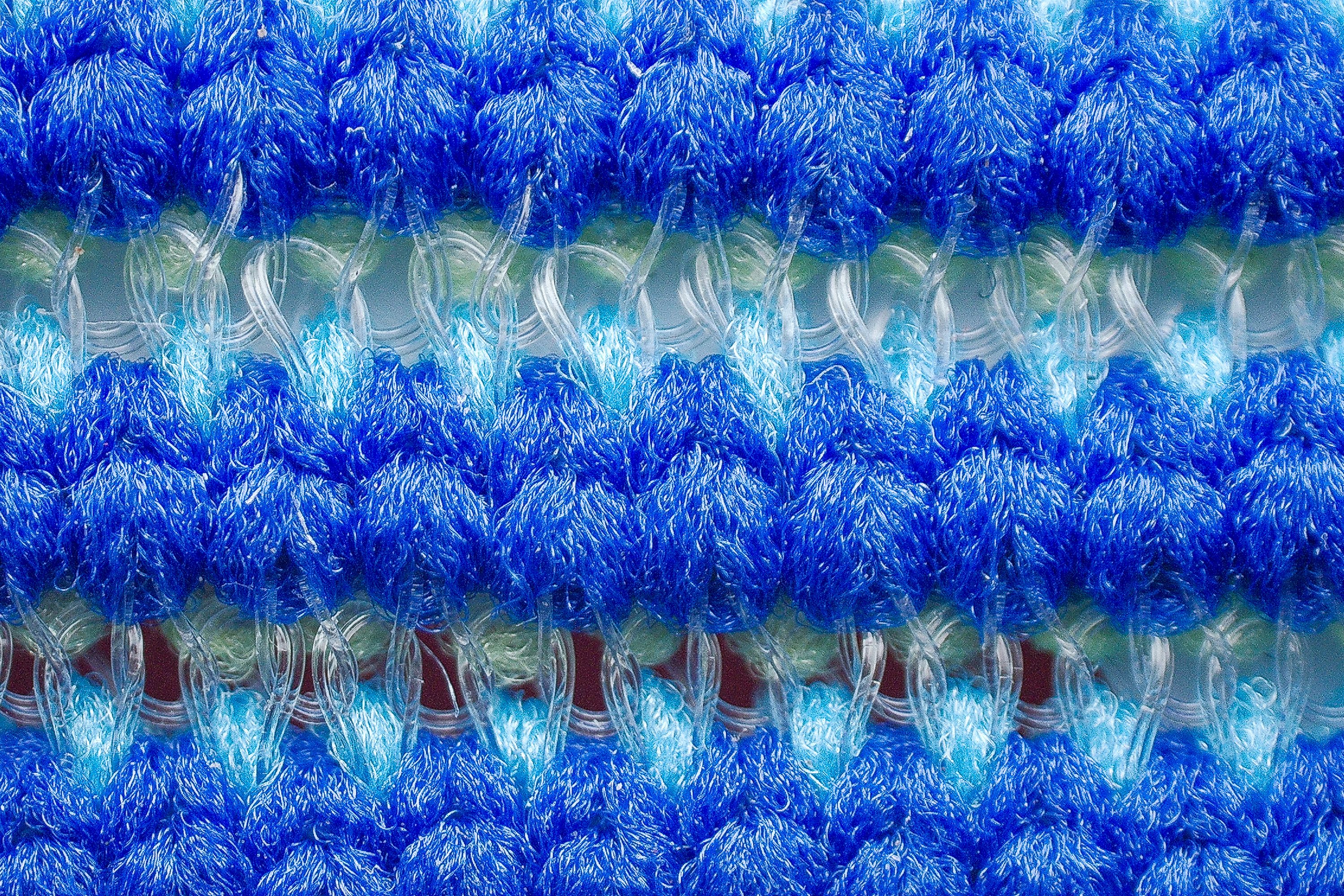
Our hands-on evaluation confirmed the upper's minimal padding.
However, this is expected in a race-day shoe, yet the material's unique upper stood out among the hundreds of shoes we've tested by its unique look and feel.
| Hoka Cielo X1 | 3 |
| Average | 3.7 |
Stability
Lateral stability test
Despite Hoka's innovative features like the winged carbon-fibre plate and reinforced midsole sidewalls, we'd suggest this shoe mainly for neutral runners who don't require extra support.
Don't get us wrong—given its substantial stack height and soft underfoot cushioning, the Cielo X1 provides a relatively stable experience. However, it truly shines for those with a neutral stride. Runners in need of more stability might find a better fit with supershoes like the Saucony Endorphin Pro 4.
Torsional rigidity
We discovered that the Cielo X1 is exceptionally rigid, a characteristic we anticipated due to its carbon plate. Despite the central cutout, which we thought might reduce torsional rigidity, our findings proved otherwise.
The shoe maintained the same impressive 5/5 rating for rigidity that most supershoes achieve in this test.
| Hoka Cielo X1 | 5 |
| Average | 3.5 |
Heel counter stiffness
Transitioning to the back of the Cielo X1, we encountered a heel counter rated at 2/5, indicating it's quite flexible yet possesses a bit of firmness. This design seems aimed at adding a touch of stability for rearfoot strikers.
| Hoka Cielo X1 | 2 |
| Average | 2.9 |
Midsole width - forefoot
Exploring the dimensions of the shoe, we discovered an additional element enhancing stability—the forefoot's maximum width extends to an impressive 117.4 mm. This generous width is particularly beneficial, offering a broader landing surface compared to narrower supershoes, which is great news for everyone, especially midfoot and forefoot strikers.
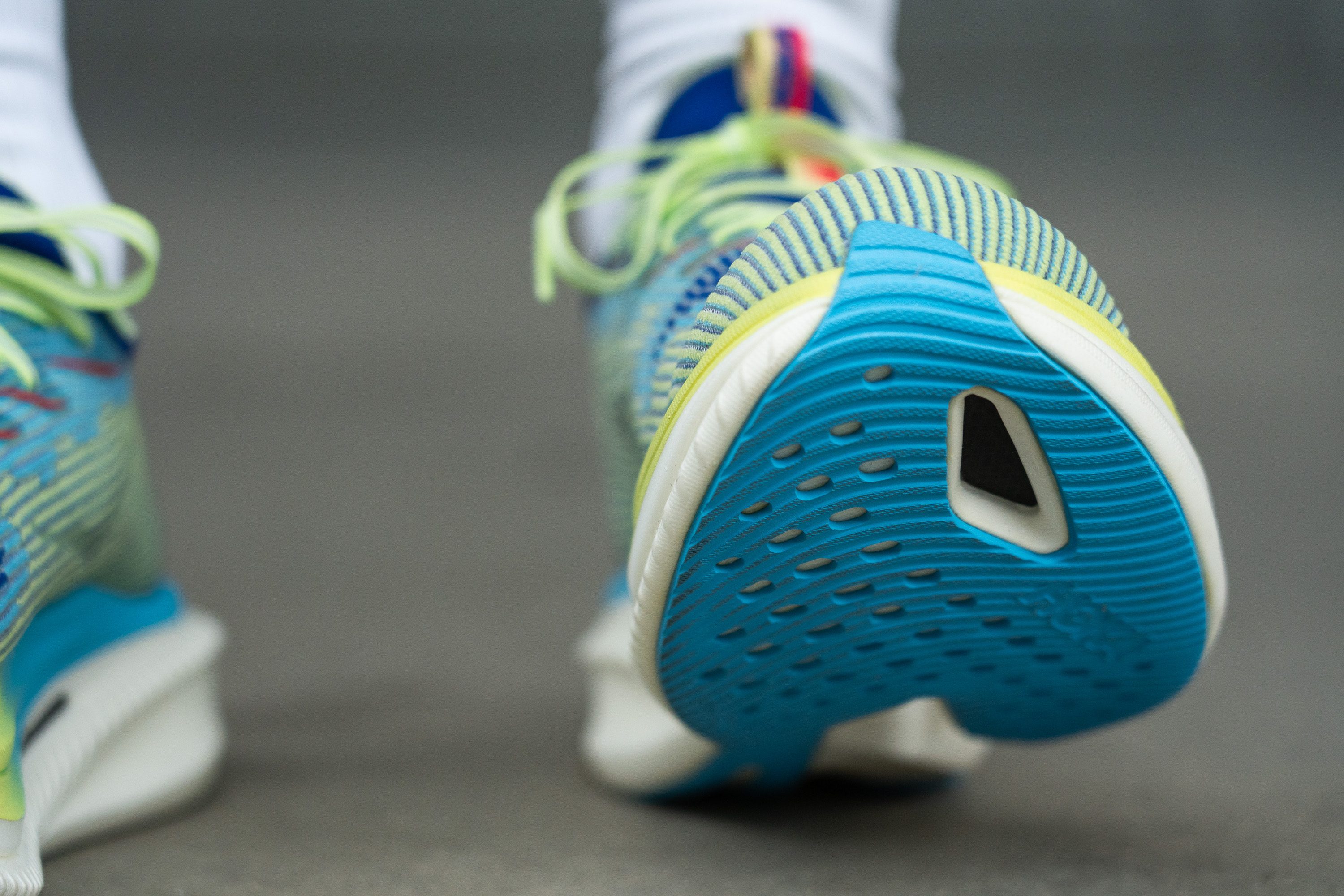
This expansive design was made possible by the significant midsole cutouts Hoka incorporated, clearly visible in the accompanying image.
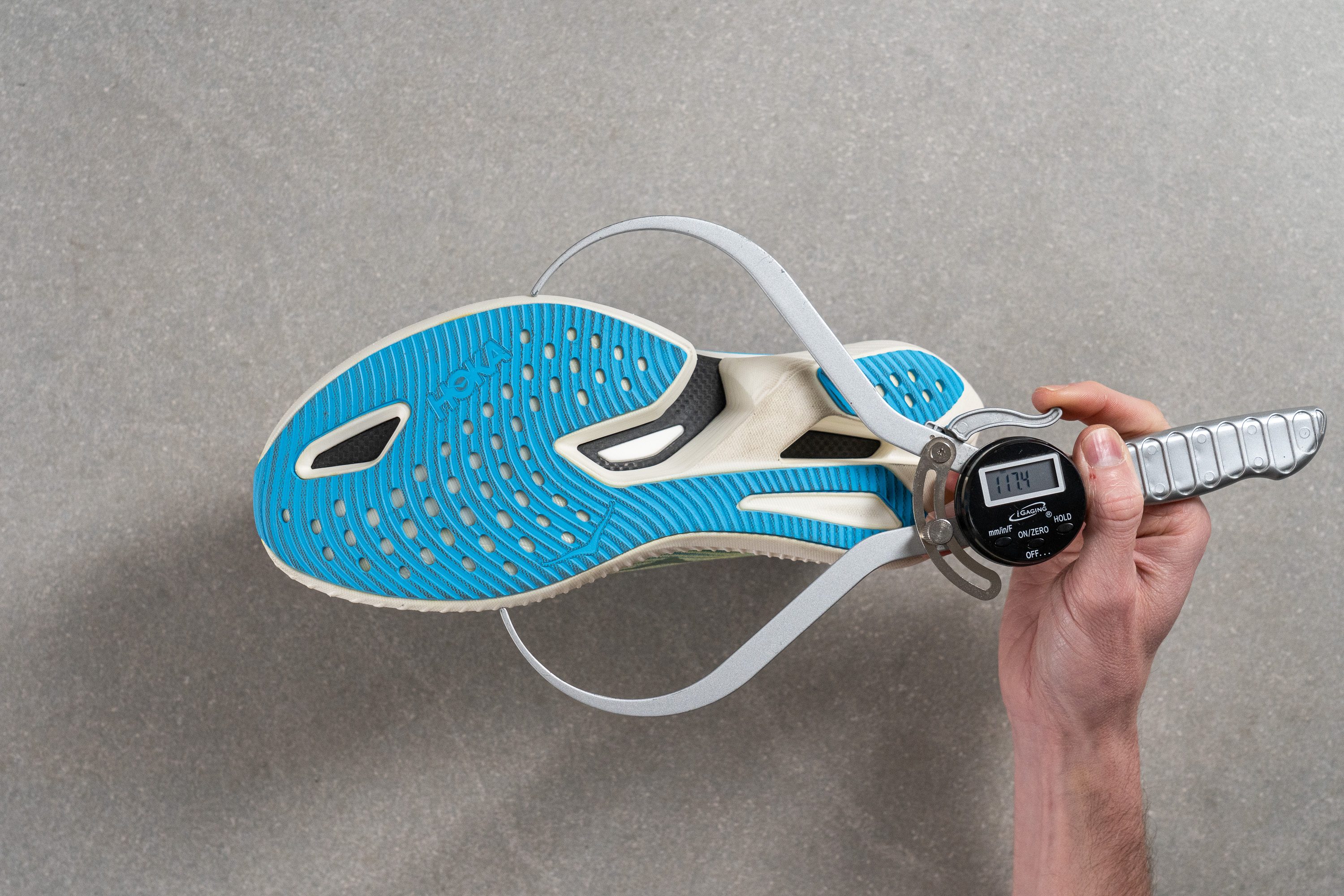
| Hoka Cielo X1 | 117.4 mm |
| Average | 114.4 mm |
Midsole width - heel
Shifting our focus to the heel, we measured a narrower width of just 89.7 mm, suggesting the shoe is designed for quicker paces that favour landing towards the front of the foot.
While we wouldn't dismiss this shoe for heel strikers, particularly neutral ones, in our view it's evidently more suited for midfoot or forefoot strikers.
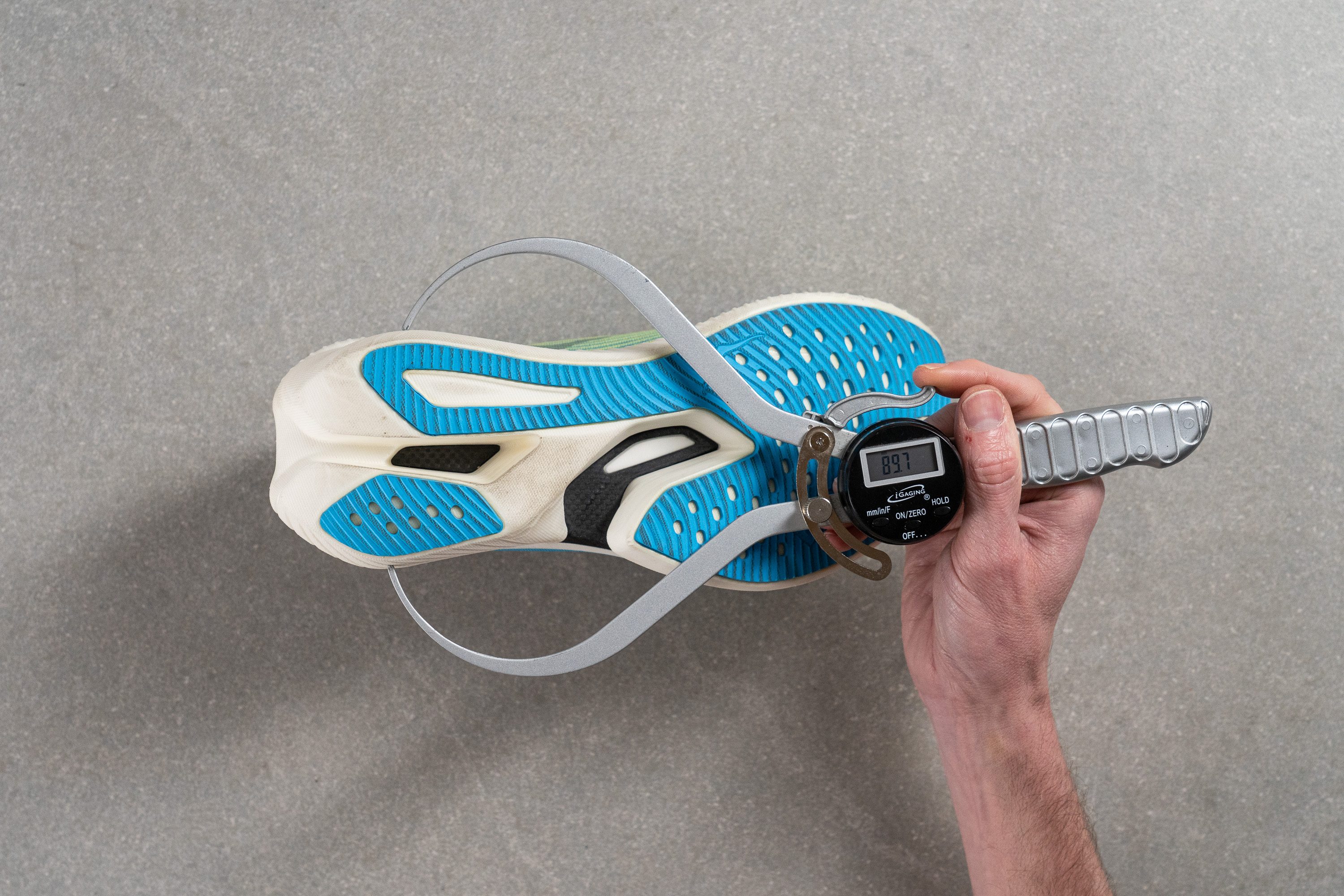
| Hoka Cielo X1 | 89.7 mm |
| Average | 90.7 mm |
Durability
Toebox durability
Immediately after concluding our breathability tests, we fired up the Dremel, eager to assess the durability of Hoka's knit. Given its rare look, we were particularly curious about its performance.
To our delight, the knit surpassed our expectations, earning a perfect score of 5/5 in our durability tests—an exceptional achievement that left us really impressed here in the lab.
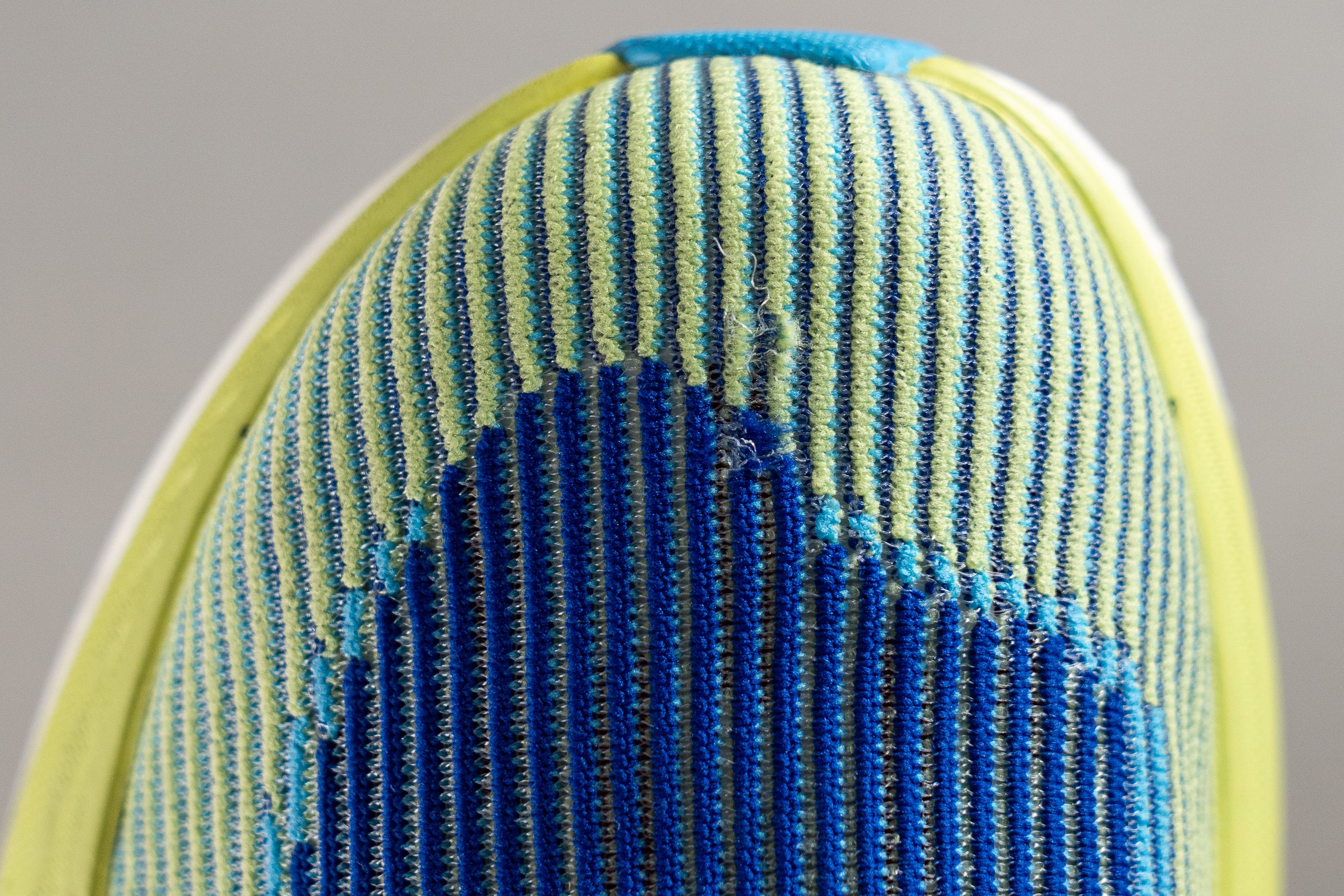
| Hoka Cielo X1 | 5 |
| Average | 2.6 |
Heel padding durability
Despite the heel's minimal padding, the material gave off an aura of toughness that piqued our interest.
As we moved to the Dremel test, our anticipation grew. Our intuition proved correct—after subjecting the heel counter padding to our rigorous testing, it withstood the challenge remarkably, securing yet another great score at 4/5!
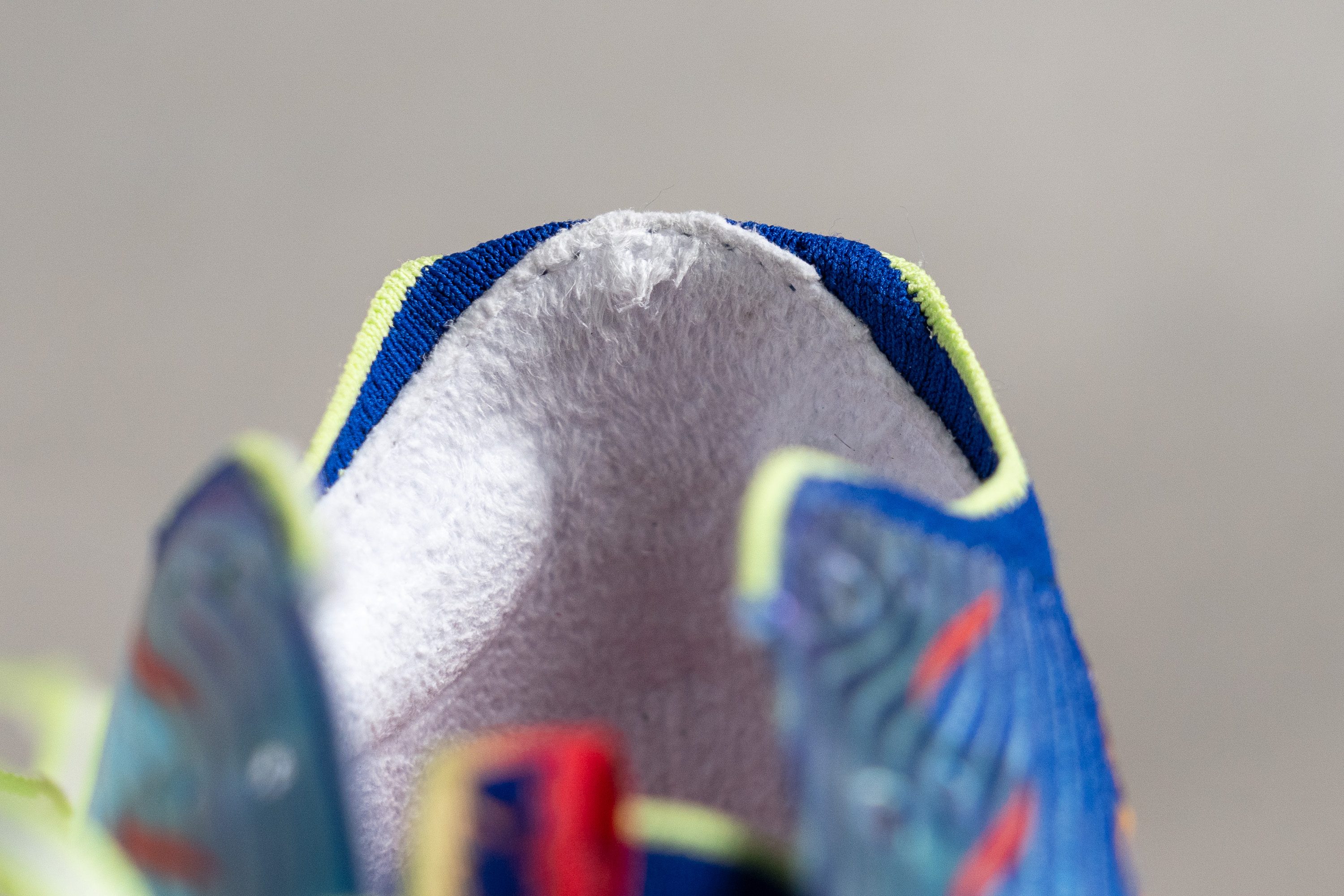
| Hoka Cielo X1 | 4 |
| Average | 3.4 |
Outsole hardness
Following our durability assessments, we turned our focus to the outsole. The rubber's hardness, measured at a surprising 84.0 HC, was harder than expected from us.

However, the Cielo X1 compensates with an abundance of rubber for being a supershoe, offsetting any concerns about grip due to the harder compound.
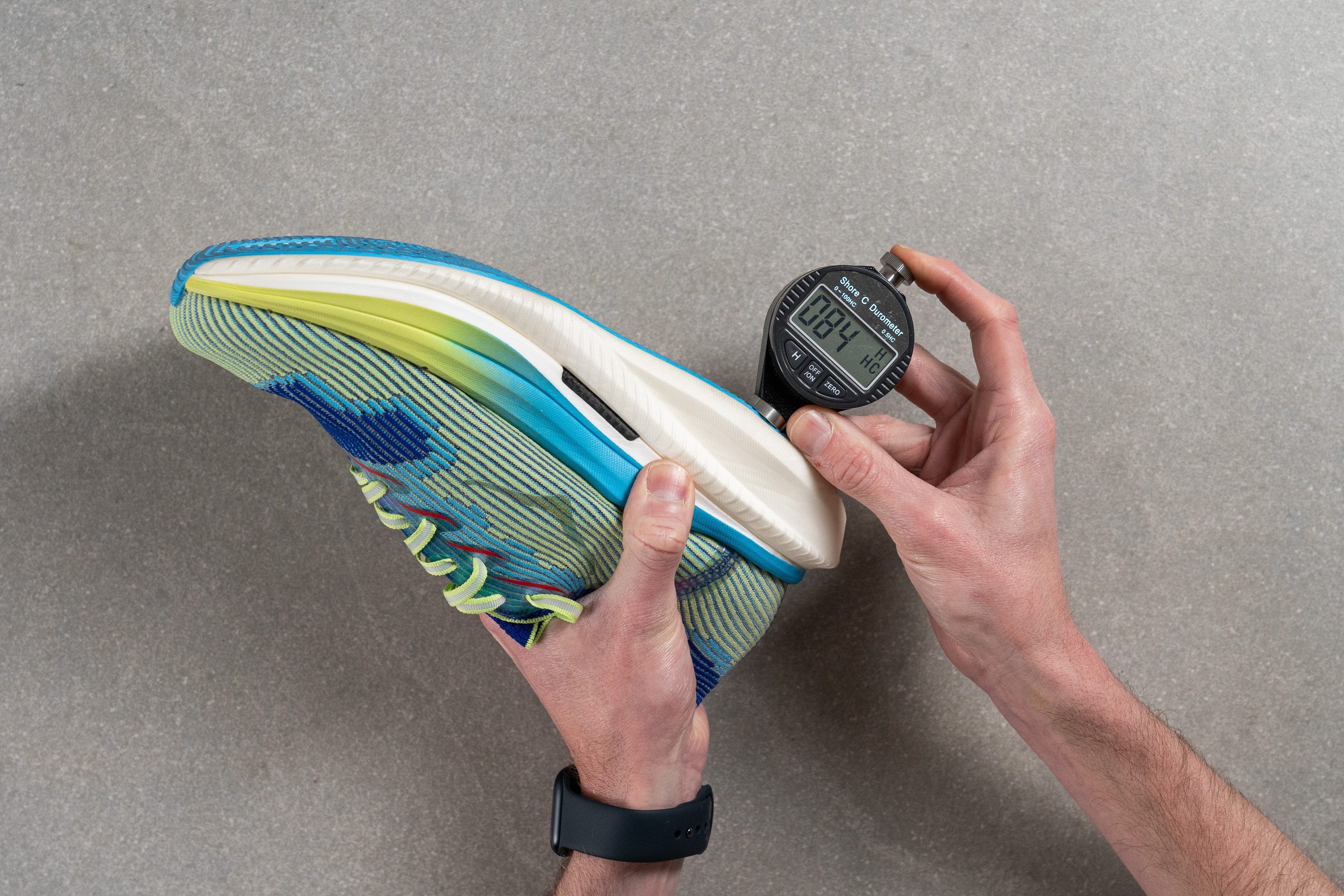
| Hoka Cielo X1 | 84.0 HC |
| Average | 79.2 HC |
Outsole durability
For our final durability test, we cranked up the Dremel's speed, as is our standard for outsole testing, to gauge the durability.
The outcome was just a 0.9-mm dent, reinforcing our belief that Hoka opted for a tougher rubber to guarantee satisfactory longevity.
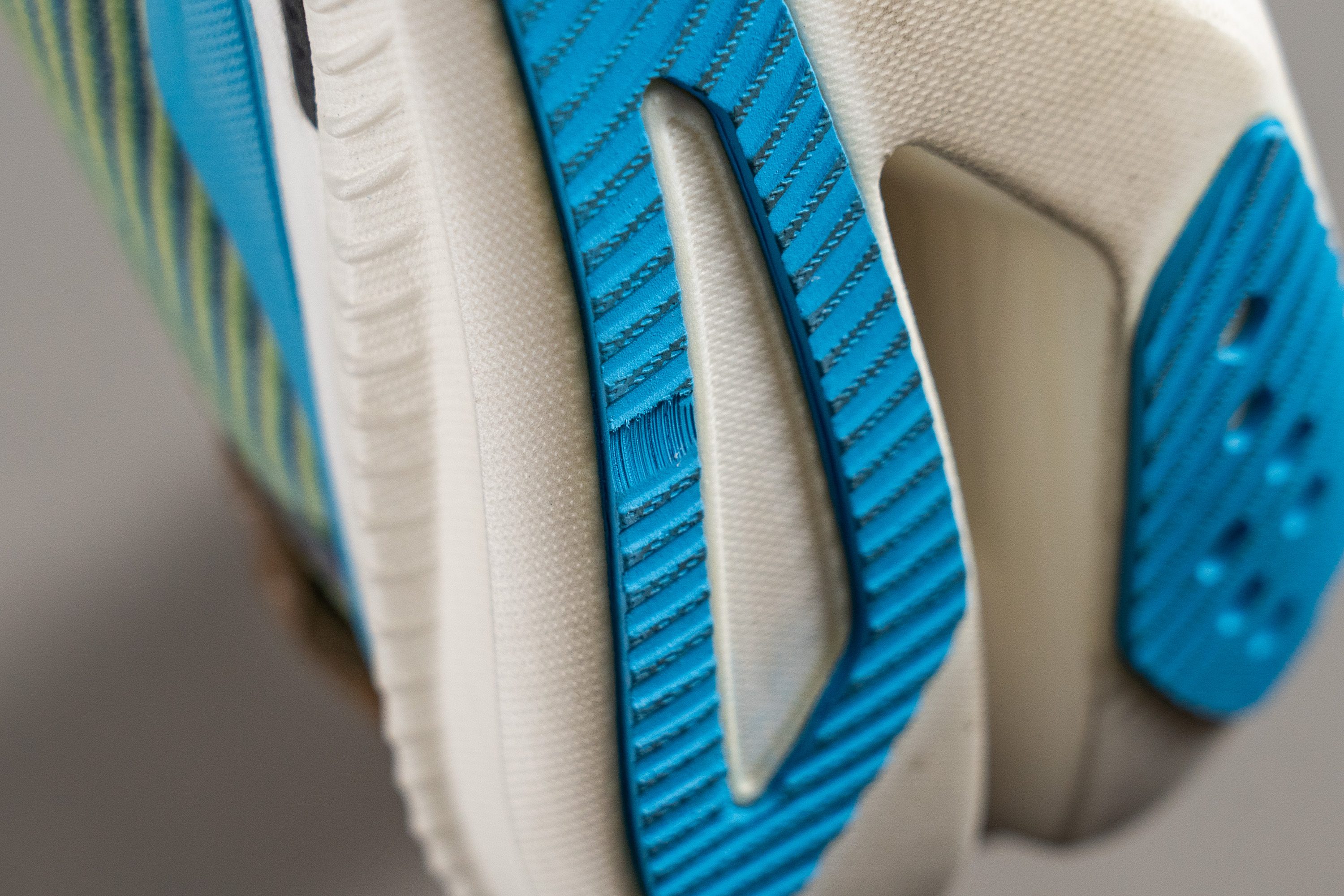
| Hoka Cielo X1 | 0.8 mm |
| Average | 1.1 mm |
Outsole thickness
Wrapping up our analysis on the outsole, we measured the rubber thickness and were surprised to find it slightly thicker than expected for a top-tier racer, at 2.6 mm.
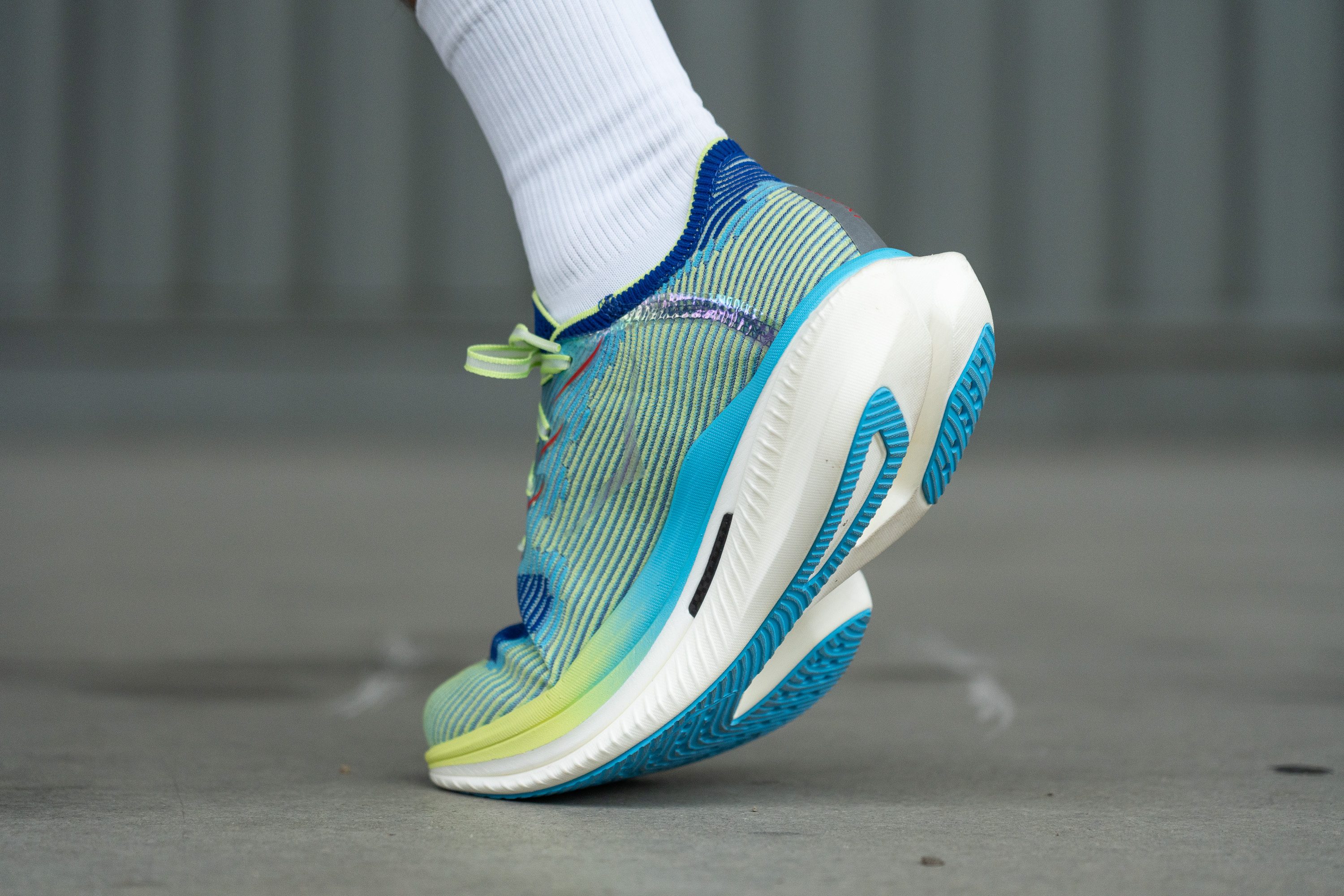
This led us to believe that Hoka prioritises longevity over minimising weight for the Cielo X1, aiming to extend its usable life without compromising performance. And naturally, they now have a remarkably easy enhancement for the v2.
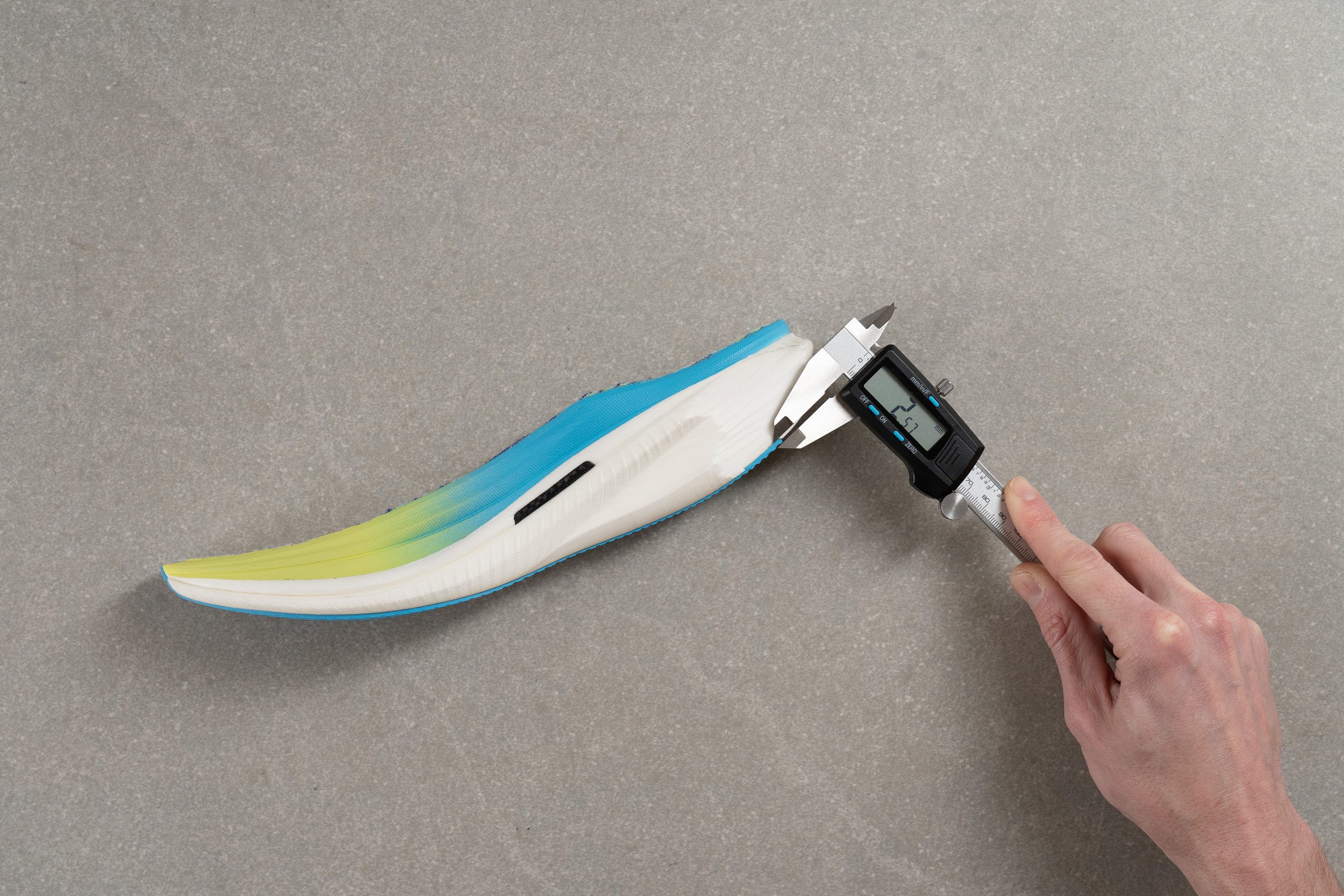
| Hoka Cielo X1 | 2.6 mm |
| Average | 3.2 mm |
Misc
Insole thickness
The insole, at 3.7 mm, is thinner than what you'd find in an average running shoe, yet it can be considered thick for a racing shoe.
We feel that Hoka could perhaps trim it down even further next time, allowing for a touch more of that responsive PEBA foam to be added, enhancing the shoe's performance while staying below the race-day legal limit.

| Hoka Cielo X1 | 3.7 mm |
| Average | 4.5 mm |
Removable insole
The insole is not glued—a standout feature not often seen in competition shoes. This nice touch will surely be valued by runners who need to use personal orthotics, enhancing the shoe's adaptability.
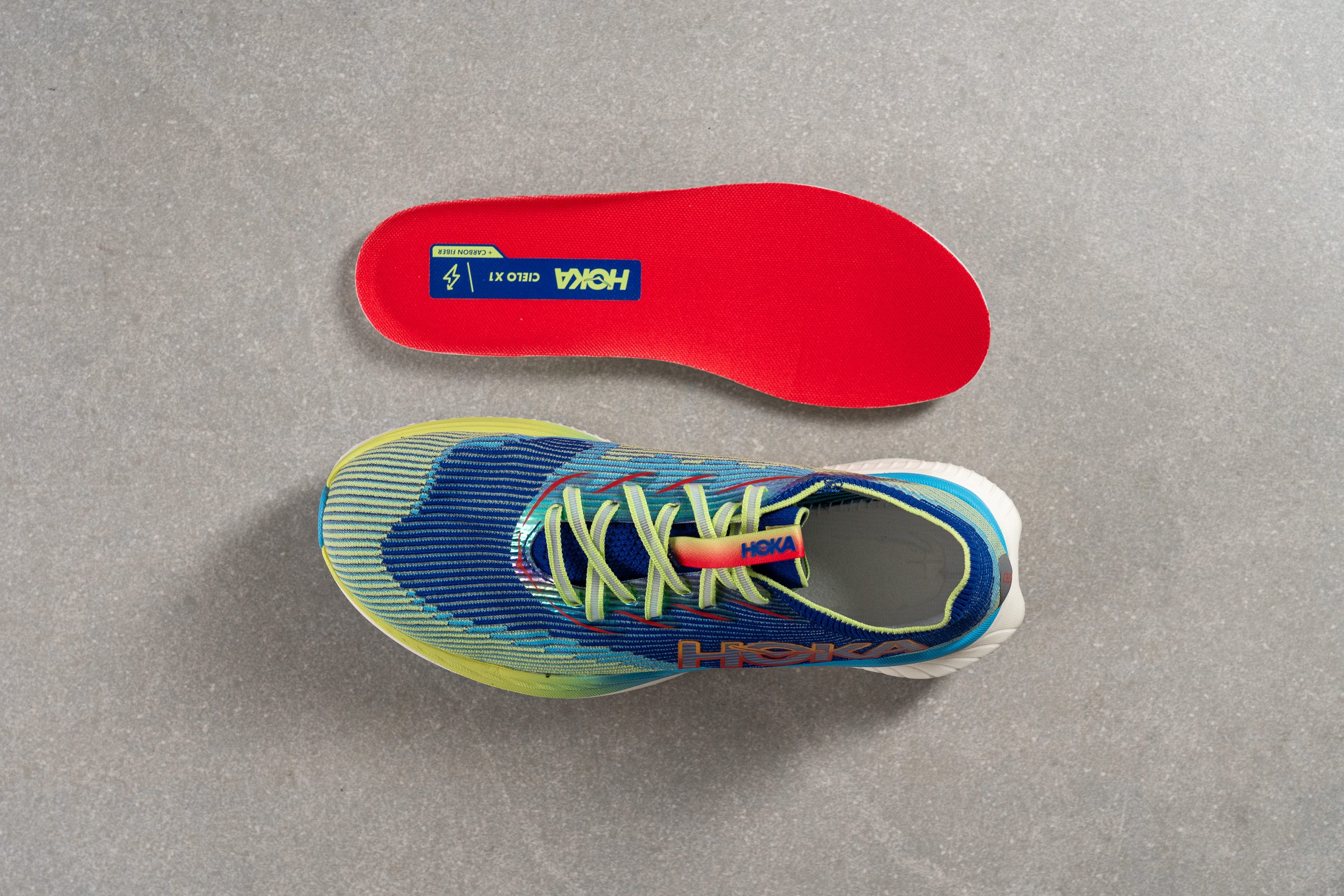
| Hoka Cielo X1 | Yes |
Midsole softness in cold (%)
To gauge how the Cielo X1 fares in cold conditions, we placed it in the freezer for 20 minutes and then tested it again with our durometer, averaging four separate readings.
The outcome was impressive—as we anticipated from such a top-tier foam, the PEBA midsole hardened by a mere 7.3%! This minor change is virtually undetectable while running, ensuring a consistent ride even in the coldest climates.
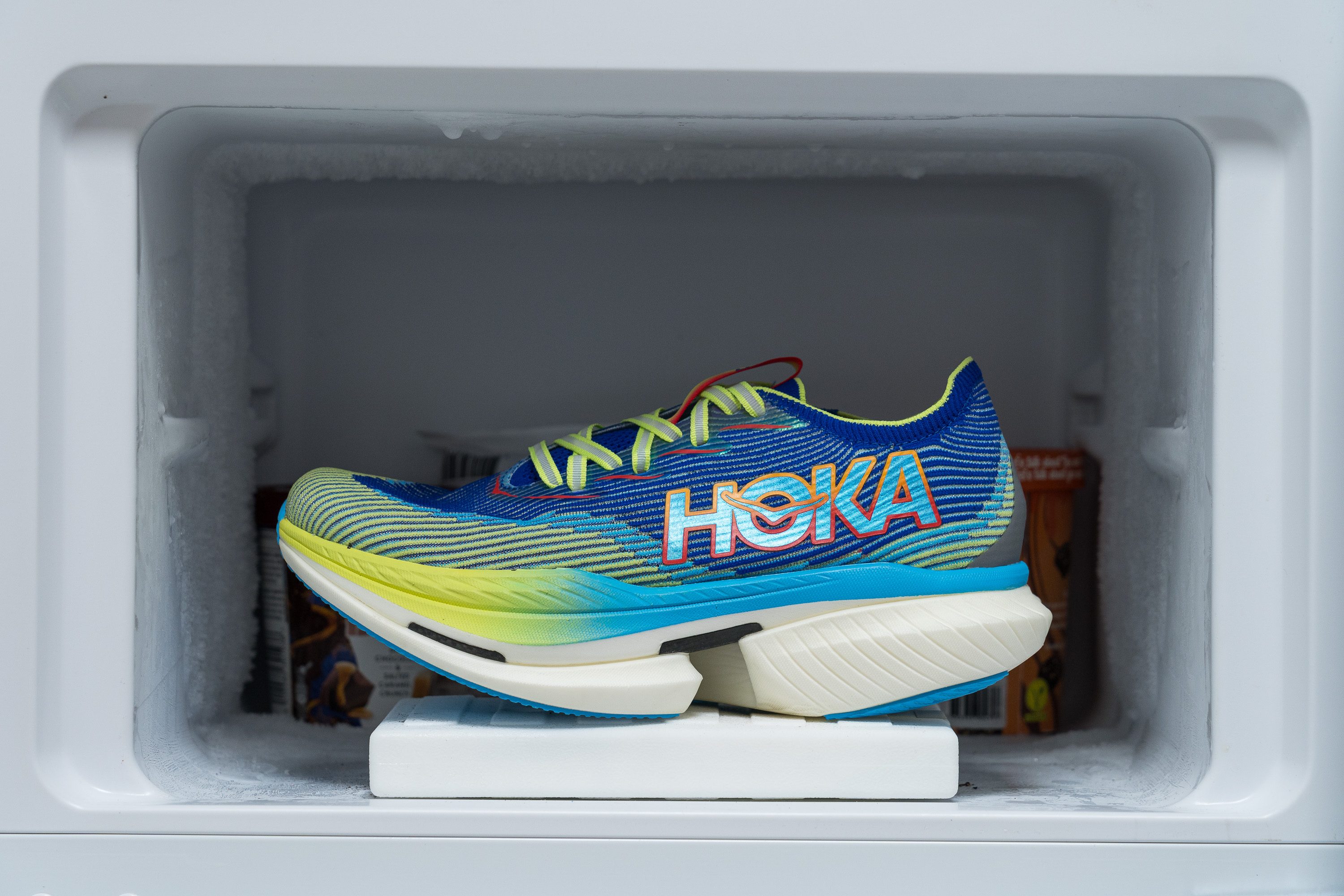
| Hoka Cielo X1 | 7% |
| Average | 24% |
Reflective elements
A supershoe that shines in the dark? Now, that's a rare find!
We found that Hoka went the extra mile by adding reflective elements to this vegan upper. So, when your long run takes you into a dark cielo, the X1 ensures you're not just fast but also visible and safe!
| Hoka Cielo X1 | Yes |
Tongue padding
Upon measuring the tongue with our callipers, we were pleasantly surprised to discover it's a tad thicker than what you'd find in most super shoes, clocking in at 2.1 mm.
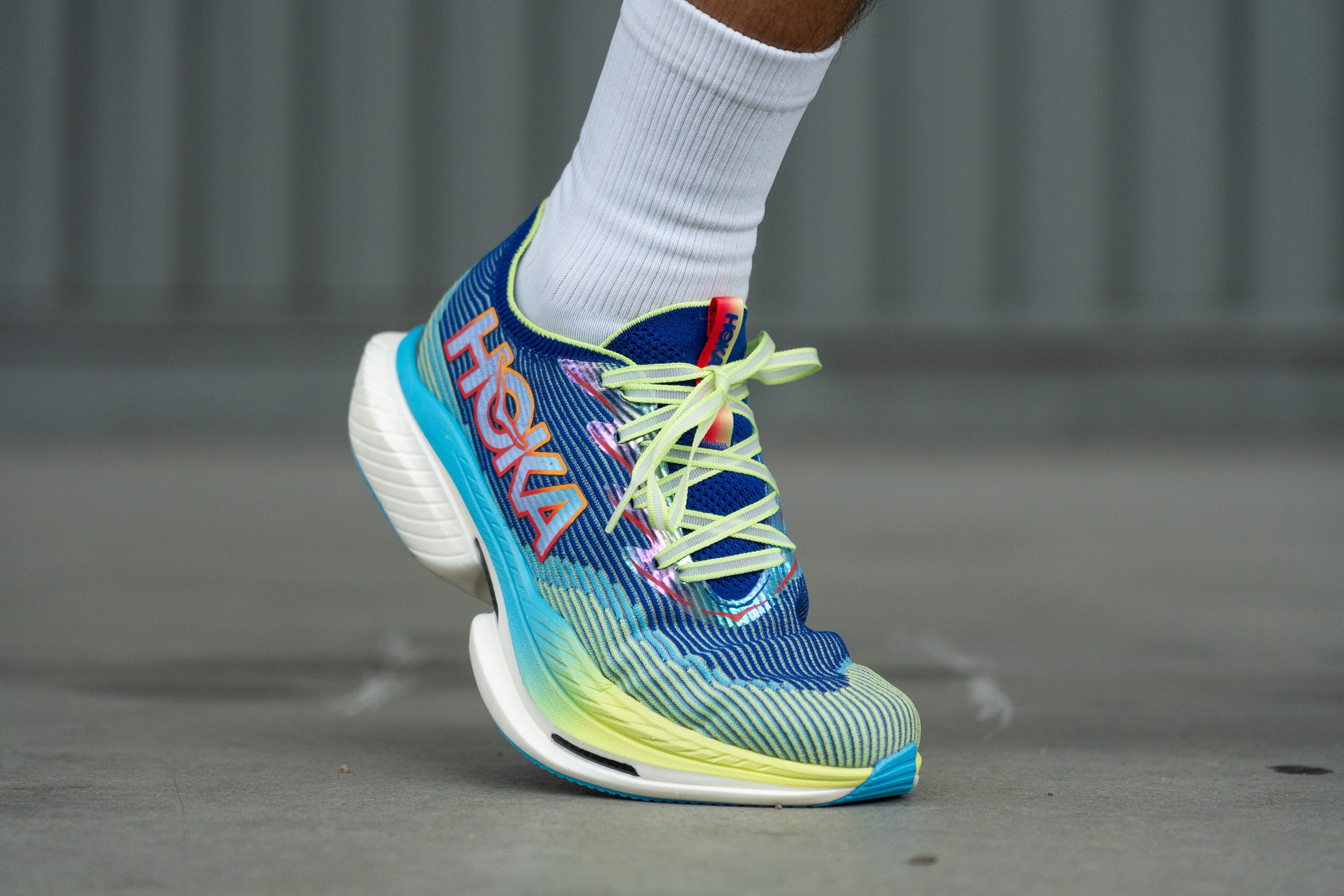
This, combined with the soft knit fabric, delivers an unexpectedly cosy feel, setting a new standard for comfort in high-performance footwear.
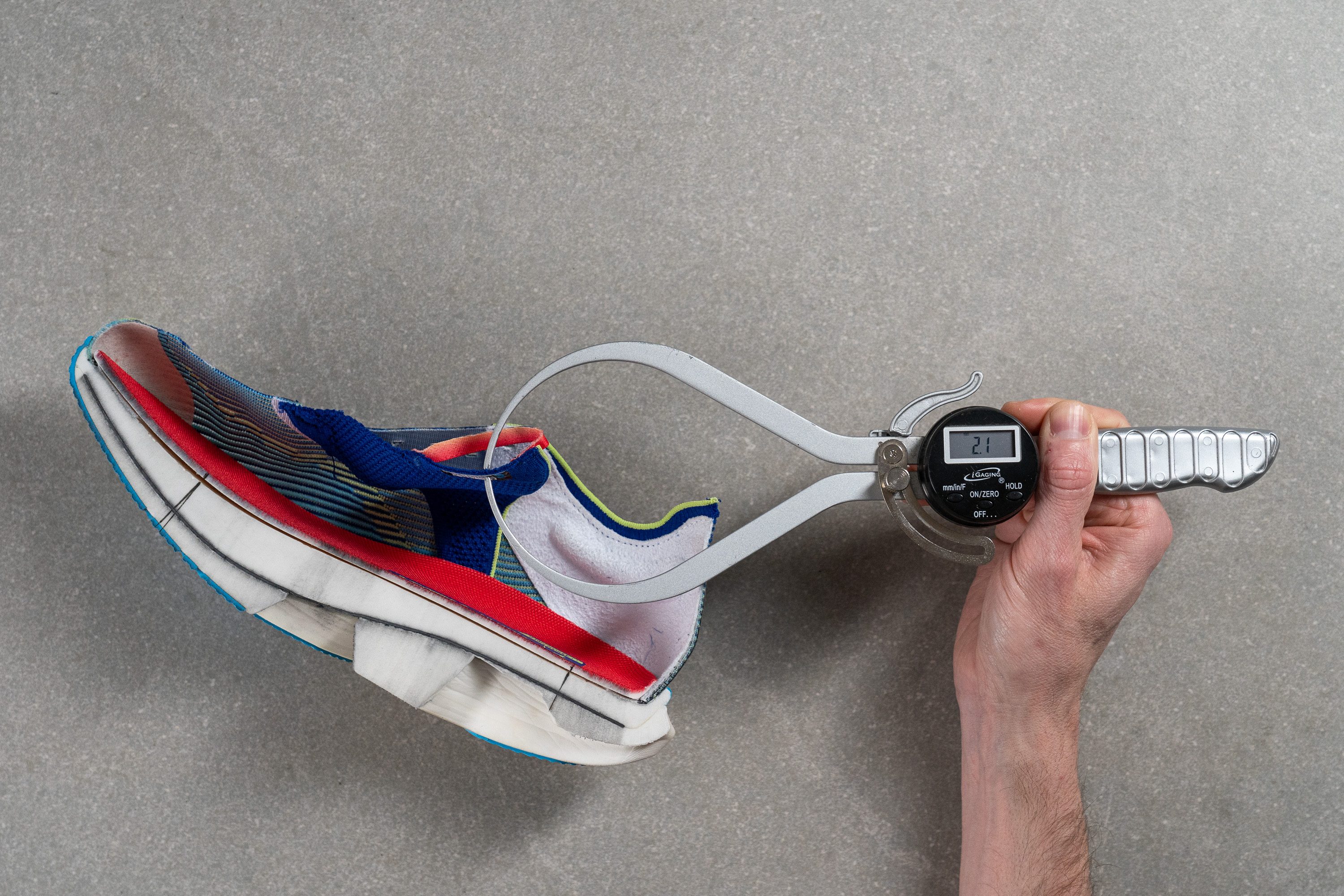
| Hoka Cielo X1 | 2.1 mm |
| Average | 5.8 mm |
Tongue: gusset type
The semi-gusseted tongue is a feature we love to see in high-end shoes. It significantly aids in securing a snug fit. And since it's only partially attached, it offers a balanced feel without being too restrictive.
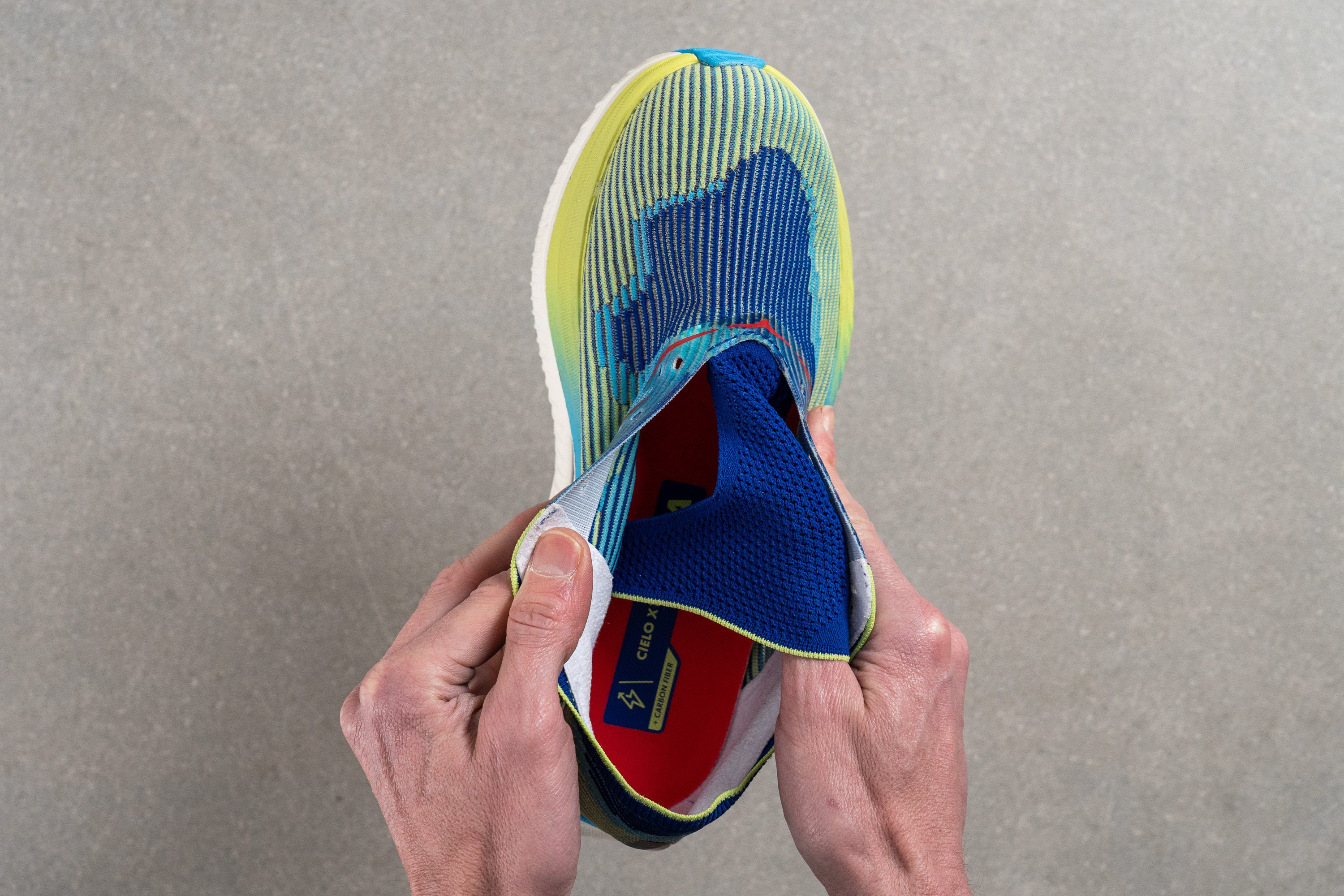
| Hoka Cielo X1 | Both sides (semi) |
Heel tab
Heel tabs are especially important for snug-fitting, knit uppers. Yet, the Cielo X1 disappointingly lacks this helpful feature.
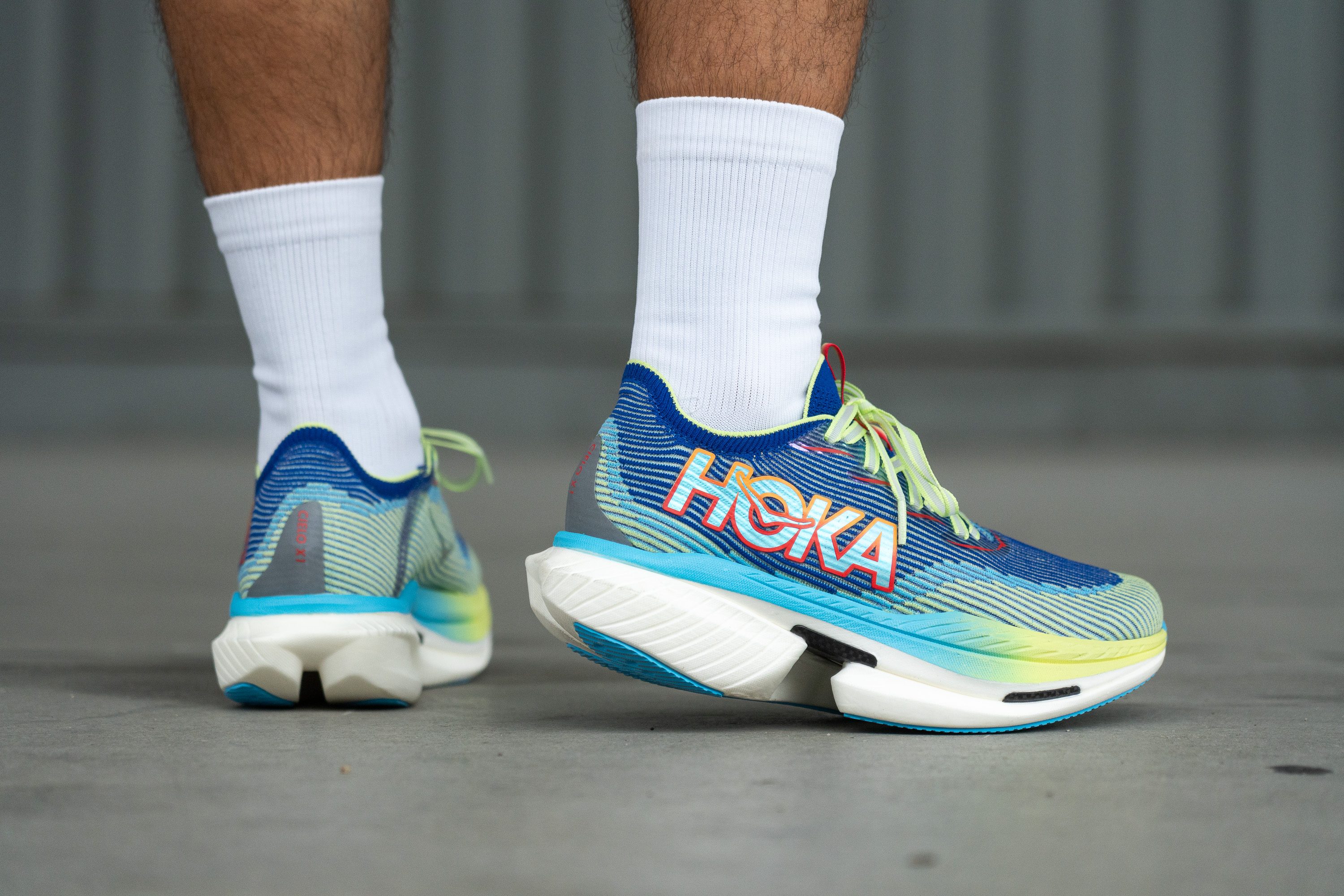
| Hoka Cielo X1 | None |

